1lumen selects and reviews products personally. We may earn affiliate commissions through our links, which help support our testing.
Amutorch DM80 review: Lumenmonster

Amutorch DM80 specifications
| Brand & Model | Amutorch DM80 |
|---|---|
| Flashlight category | long-range searchlight / lumen monster |
| LED | 8*Luminus SFT-40-W |
| Max. output | 18,000 Lumens |
| Max. beam distance | 1389 meters |
| Max. beam intensity | ? cd |
| Battery config. | 3*21700 |
| Onboard charging | USB-C |
| Modes | 5 stepped+smooth ramping |
| Blinkies | Strobe |
| Waterproof | IP68 |
| Review publication date | November 2022 |
Introduction:
It’s no secret that the Chinese manufacturers have been busy of late, cranking out some super impressive flashlights at impressively low prices. Without sounding subjective, I’ll freely admit that I have a soft spot for Amutorch products. They feature simplistic, rugged, no-nonsense designs and ergonomics, simple UIs in a sea of Anduril lights, and more importantly, features found on higher end lights.
I’ve reviewed 3 Amutorch lights so far, and have come away impressed each time. Well, Neal Zhang (of Nealsgadgets), sent me a couple of lights to test on, and included something new from Amutorch. Here’s the shortlist of its features: 8 Luminus SFT-40-W LEDs, 3×21700 batteries, USB C charging, and a high-performance buck driver to the tune of 18,000 Lumens and almost 1400 meters (advertised) throw in a relatively-compact soda can form factor. Sounds nice. I’m not sure if Amutorch intended this to be a competitor to the Manker MK38, but it’s the only other 8x SFT-40-W light out there (at almost ⅓ the price). Let’s check it out.
Package quality.
I don’t expect nice packaging from budget Chinese flashlight manufacturers. Most of the time I get a box, with a flashlight and some bits inside. That’s it, and I’m fine with that. The DM80 came in a nice rubbery carry bag (like the DM90) with some accessories secured in foam:
- Amutorch DM80 flashlight
- Carry bag
- Handle
- 2 spare o-rings
- Two handle screws (one allen head, one slotted with a swivel)
- Two handle washers
- L-shaped Torx wrench
- Lanyard
- Manual (in Chinese)
Okay, so the manual is in Chinese and unreadable for almost everyone outside China. Thank goodness for Google Translate. The light didn’t come with batteries, but you can add them to your order, and unless you have 3, matched, identical, 21700s of the same brand, age, capacity, and discharge capabilities, I recommend getting them. They’re cheap, and the batteries Neal includes are usually really good.
The rest of the accessories are similar to what I got with the Amutorch DM90 (minus the little container of silicone paste), and very appreciated since most lights I get from Neal come with nothing. The l-handle wrench is supposed to be for the battery carrier, but it’s not really a user-serviceable item.
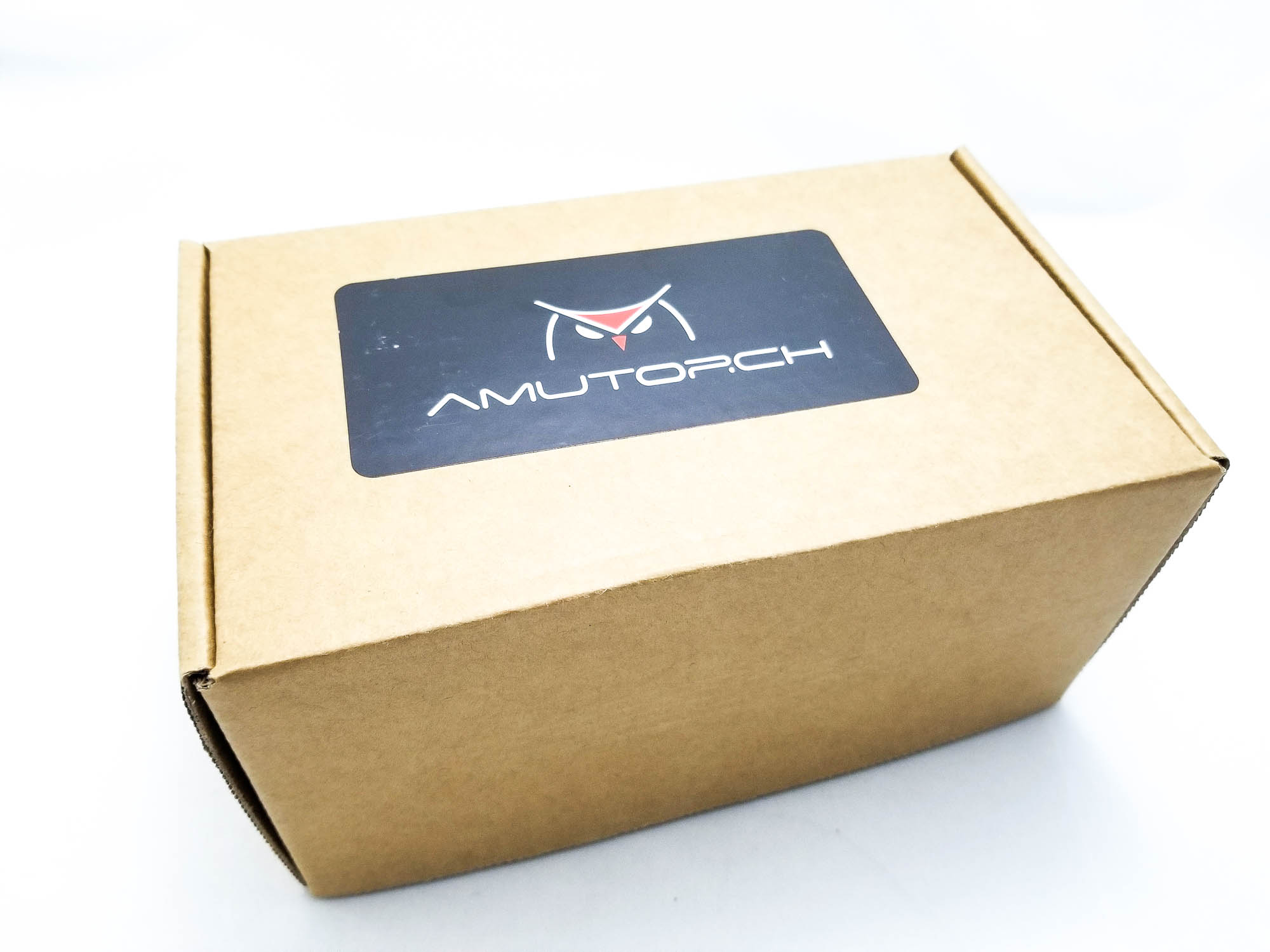
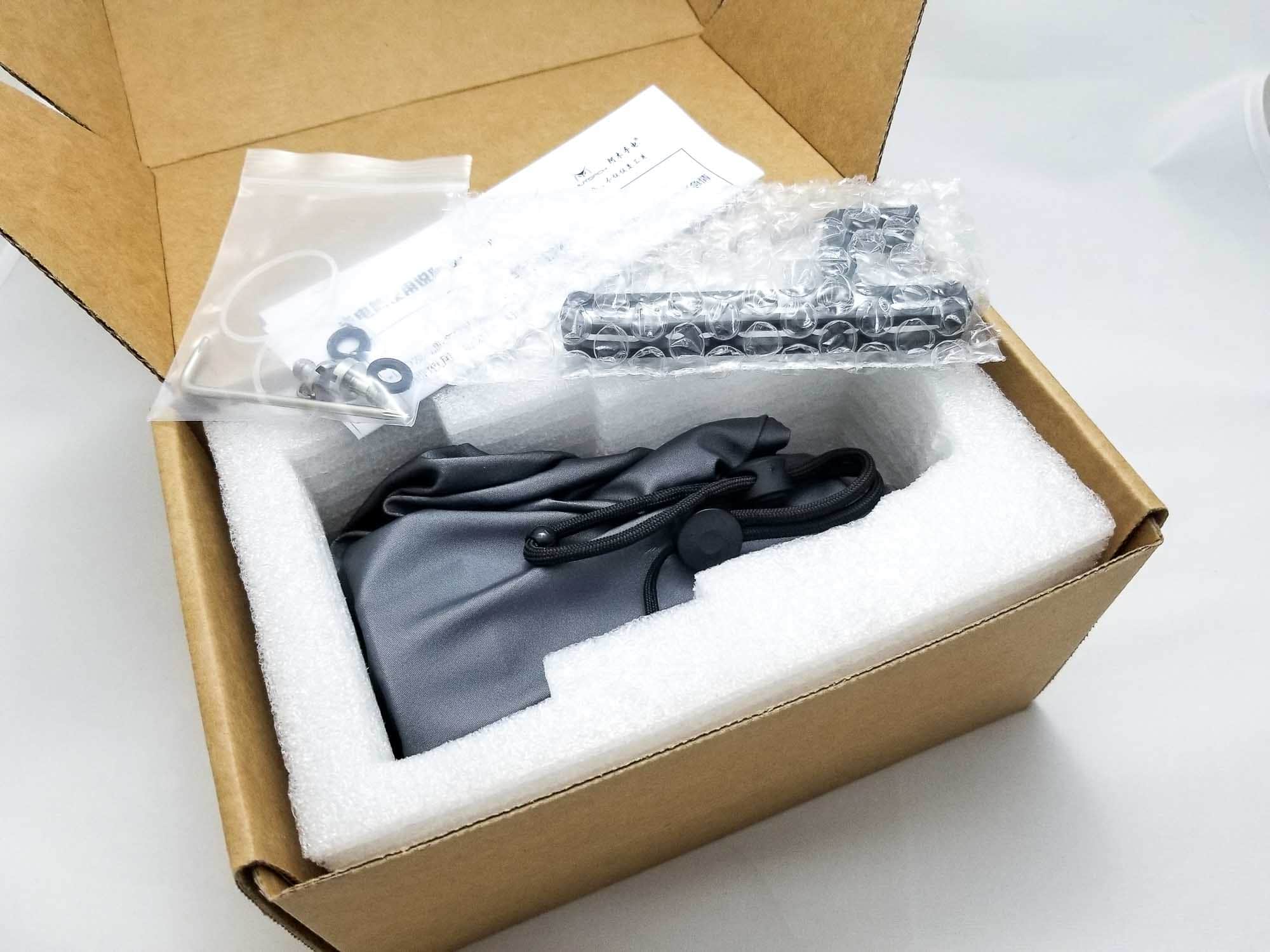
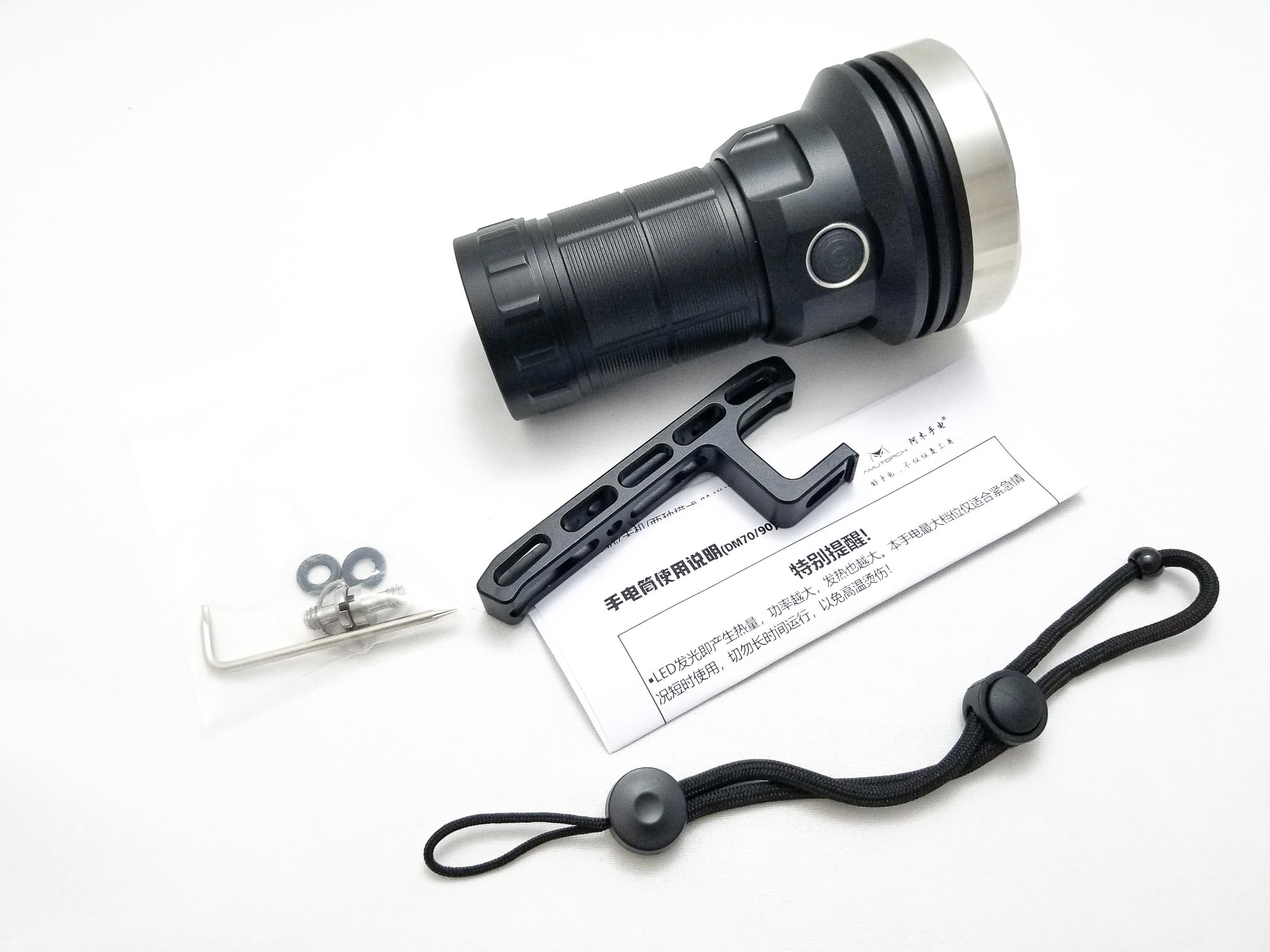
Flashlight in use
The DM80 occupies a special corner of the use-case continuum, excelling at casting large amounts of light long distances. This is good for surveying, inspecting, or chasing off critters (2-legged and 4-legged). Amutorch does include a detachable handle to help with toting it around, which is necessary (and keeps your hands away from the hot bits during extended use). The handle is pretty cool looking and is skeletonized with cutouts for weight reduction.
Form-factor wise, this is a soda or soup cap style light, featuring a short battery tube with a wide, flat base. The whole light is just 135 mm long, which is pretty compact. There’s reeding for grip on the tube, and vertical grooves on the rear for gripping. The battery tube unscrews to access the battery carrier, and if you just want to charge the light, you can unscrew the tailcap to access the USB type C charge port integrated into the battery carrier. The screw hold for the handle is threaded for ¼ UNC, so you can mount it to a tripod.
There’s a single, large e-switch for switching duties, and it looks lifted from the DM90. It sits in a shiny aluminum bezel and sticks up a bit, so finding it was easy by feel. The boot is translucent with some aux LEDs underneath for on state and battery status (they aren’t illuminated on standby). The switch action is nice, with accurate, well-defined clicks. It’s offset about 45 degrees from the handle, so unless you’ve got hands like Andre the Giant, you can’t use the switch with one hand when holding it by the handle. Tail standing was easy-peasy and super stable, which is mission-critical for a light like this for area illumination, and it won’t roll off an incline with the handle attached. There’s no lanyard holes, but you can thread the lanyard through the swiveling bail on one of the handle screws or the cutouts in the handle.
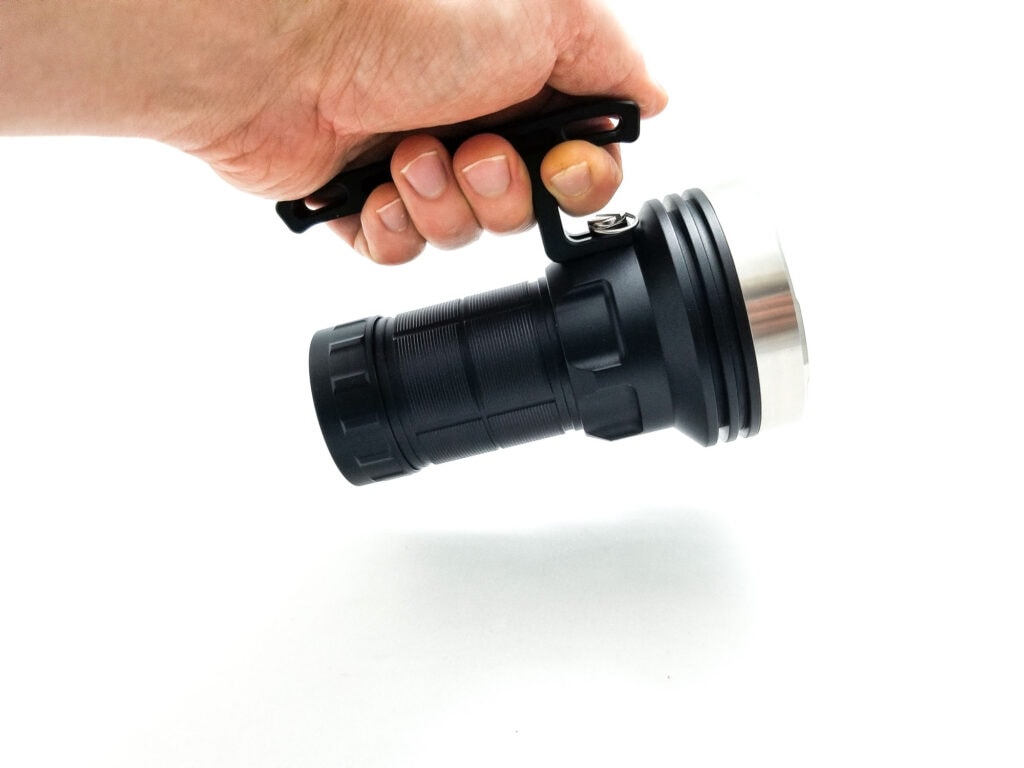
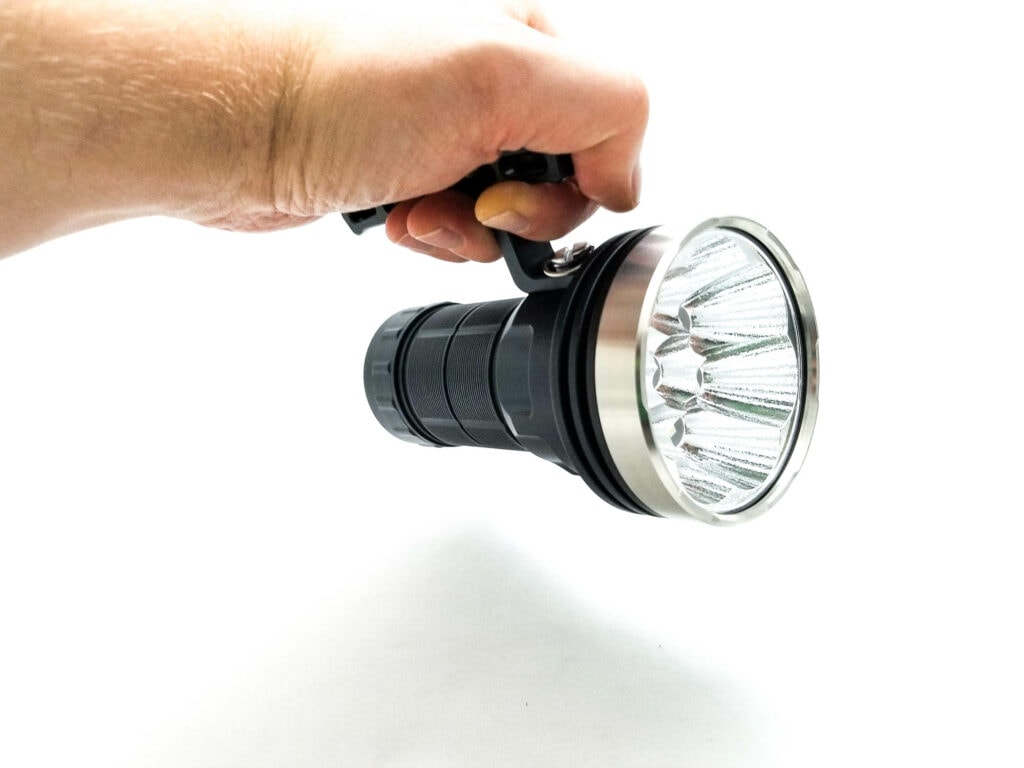
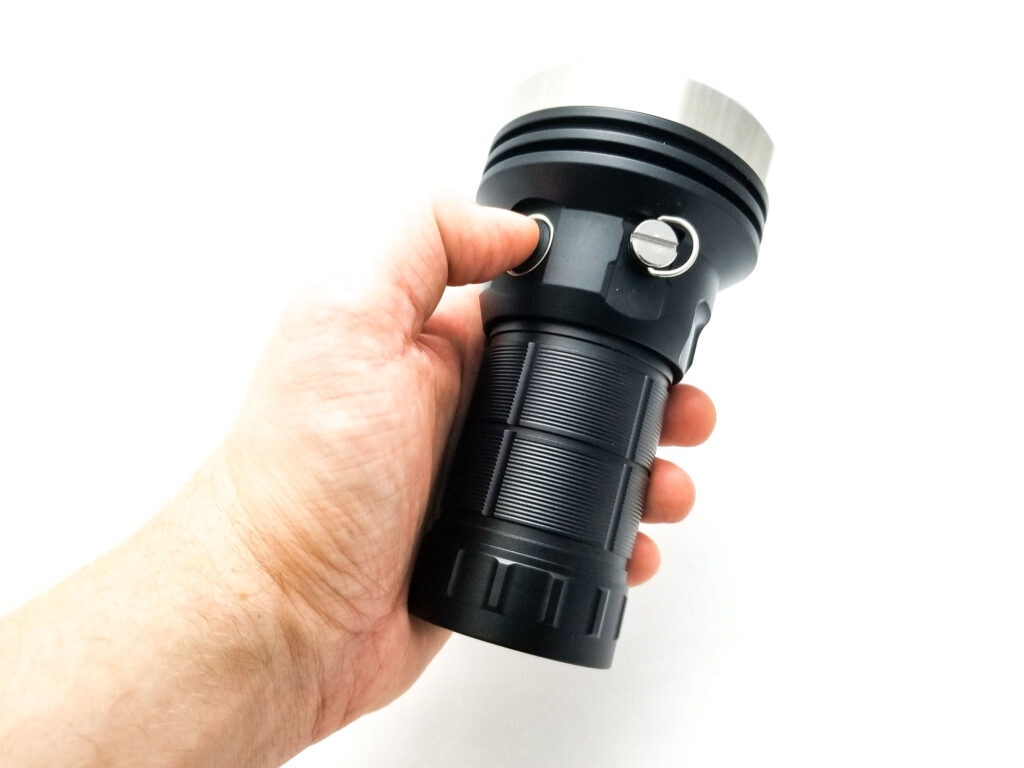
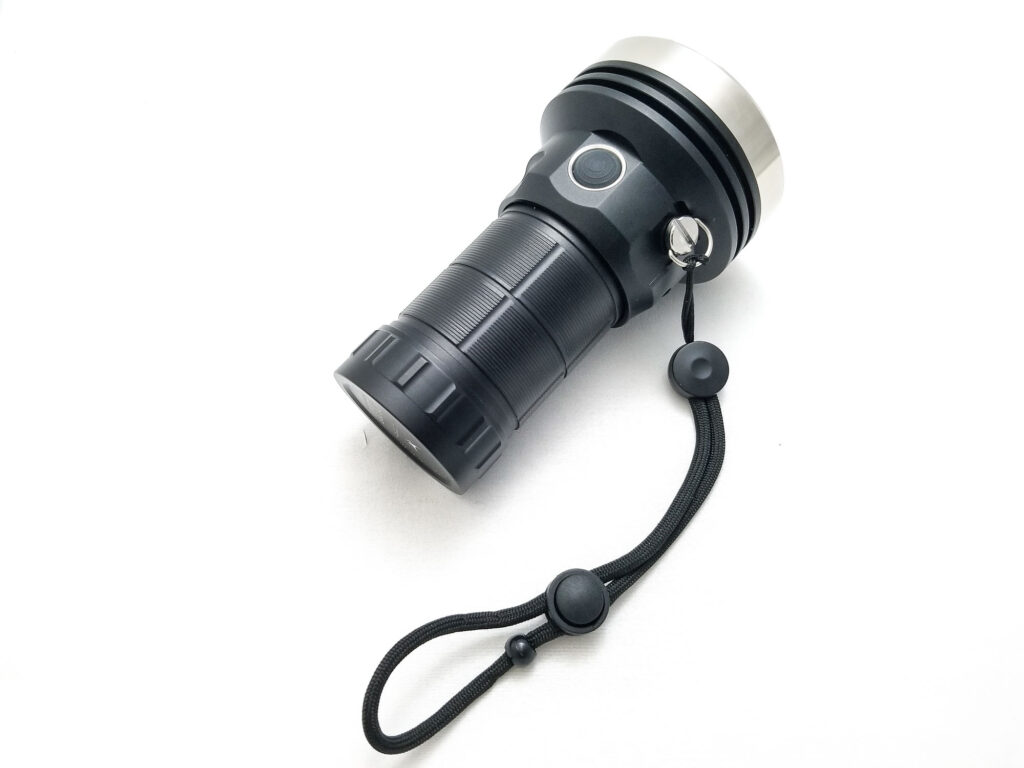
Build Quality, and Warranty
Amutorch lights are generally well-made and the build quality is usually great. The DM80 retails for between $160 and $195 depending on where you buy it (and whether you opt for batteries, which I recommend), and that’s a really good deal for what you get. Just the emitters alone cost about $70, and the next-closest competitor, the Manker MK38 with SFT-40-W LEDs runs around $330.
The light is made from an unidentified aluminum, probably 6061-T6. The machining is sound and defect-free, unlike the other Amutorch lights I’ve tested, and sharp edges have been knocked down. The huge stainless bezel is very nicely finished as well, with no defects or errant tool marks. For the finish, it’s not advertised as type III HA, and it’s similar to the other Amutorch lights I’ve tested; a semi-matte black anodizing. It’s nicely done, with no discernible defects or coverage issues, which is nice since every other Amutorch I’ve tested has had finish anomalies of some sort.
The threads at the tube front and rear are square cut and had plenty of lube, but were still a bit scratchy. With a single o-ring sealing the front and rear of the tube, an o-ring at the bezel, and the lens, Amutorch gives the DM80 an IP67 rating. The light can be disassembled down to the MCPCB and driver, but I’d only recommend it for adventurous or experienced modders since there’s a lot going on under the driver cavity. The LED wires look to be 18 gauge, and the solder joints look great with no sloppy flux residue.
The driver is held in with an aluminum retaining ring secured with 3 phillips screws, and once removed, the driver can be dislodged. But the LED wires must be de-soldered at the MCPCB and the switch wires liberated before the driver can be removed. There’s a single spring at the driver, and the 3 springs on the battery carrier are non-magnetic high current BeCu units and pretty thick so they should handle the high current demands.The battery carrier looks well made, with nice solder joints, thick PCBs, and wide traces.
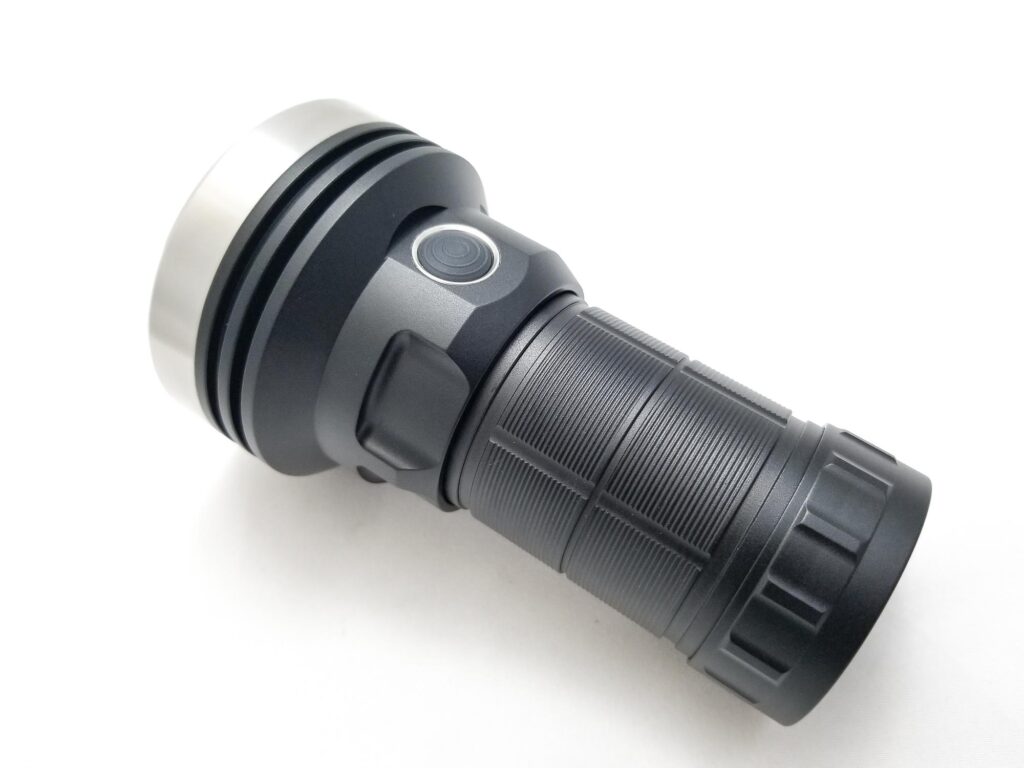
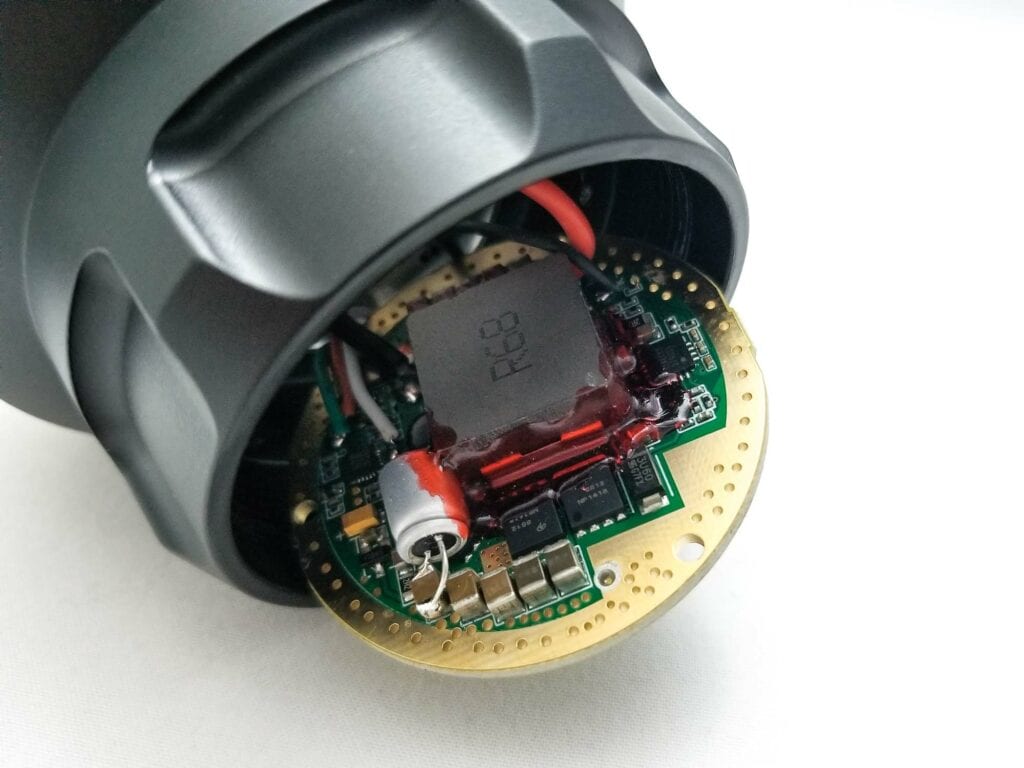
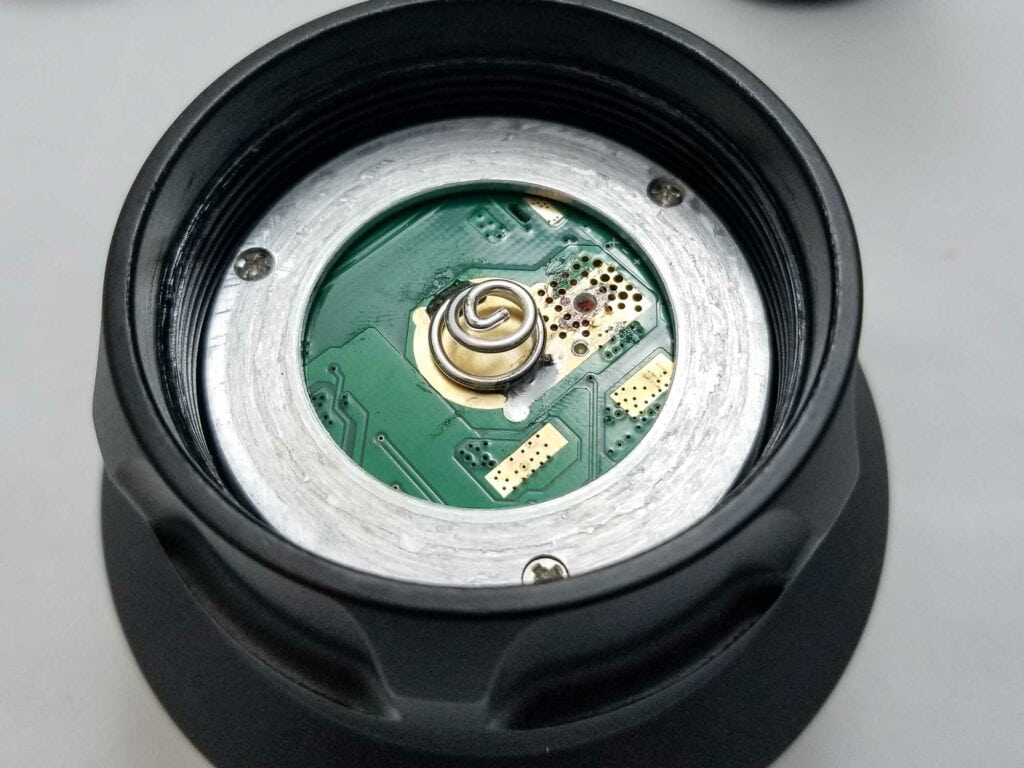
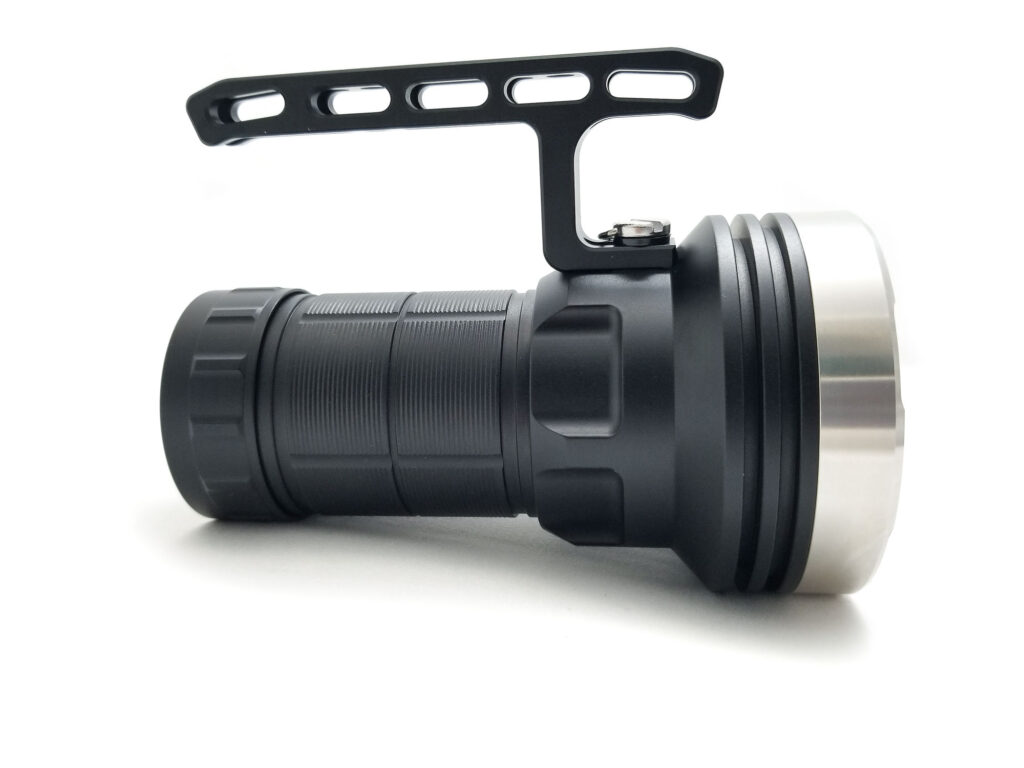
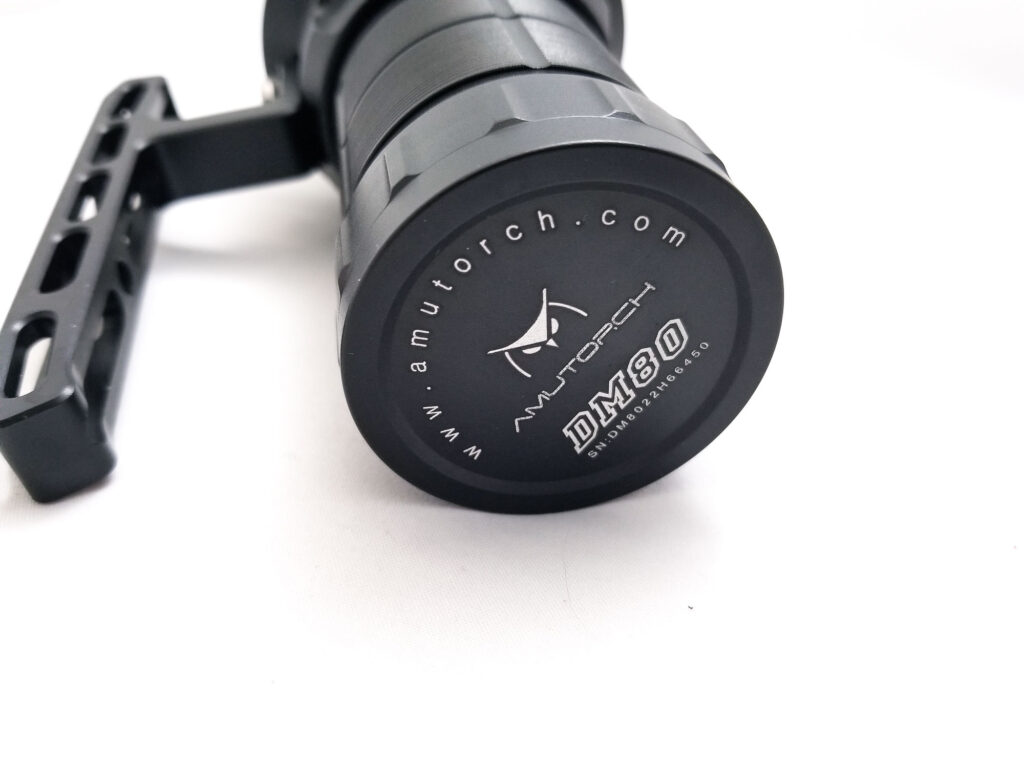
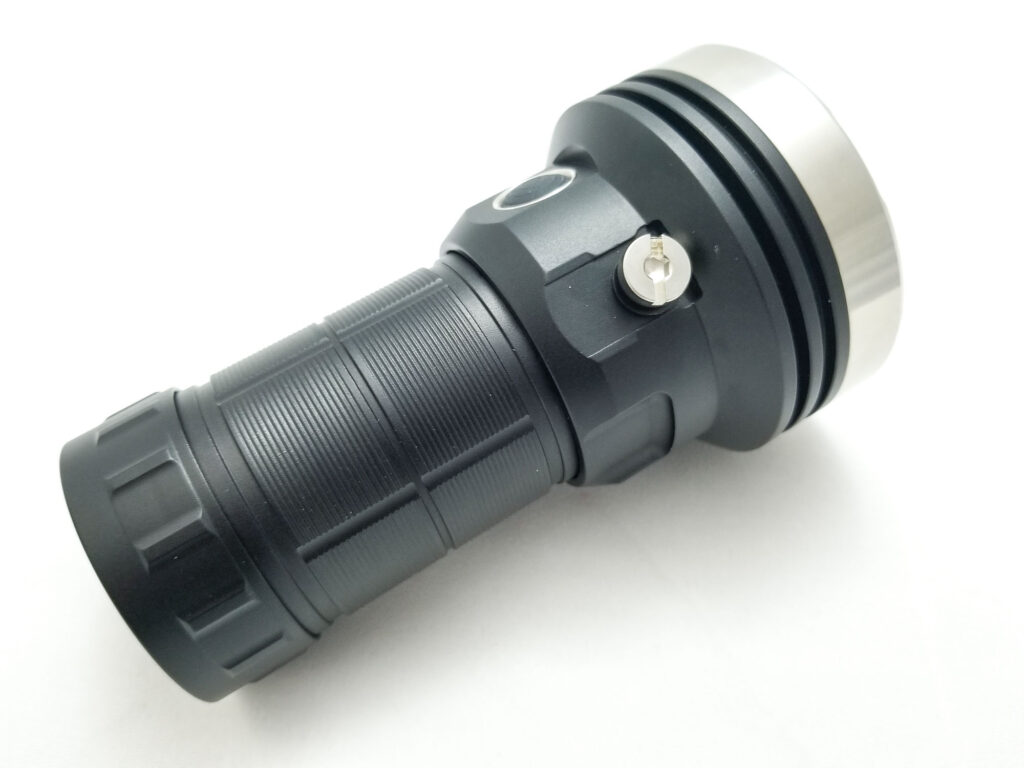
LED, Lens, Bezel, Beam, and Reflector
The LEDs are none other than the Luminus SFT-40-W and what’s better than one SFT40? How about eight! The SFT-40-W has been around the block a few times, but is a domeless, high-intensity 5050-size emitter. With a 3 volt forward voltage and a low thermal resistance, it’s an efficient emitter that’s proven itself in tons of new lights.
I’ve reviewed a bunch of lights with this LED and it’s an impressive performer and a great replacement for the Osram Boost HX. The LES is a bit larger(4 mm2) than the Osram CULPM1 and CSLPM1 LEDs, so you’re getting great throw with a more useful beam and a larger hotspot.
The reflector is an 8-cup LOP (light orange peel) unit with a central LED and 7 lining the periphery. This combination obviously gives tons of flood along with very impressive amounts of beam distance. The reflector is topped with an AR-coated mineral glass lens. The bezel is a very finely machined stainless unit. It’s crenelated and will do a good job protecting the lens. The beam? Tons of flood and lots of throw. The multiple LEDs are nicely focused and produce a bright center hotspot (although it’s only really visible on High mode) with a bright corona and diffuse spill.
On lower modes, it’s tame enough to use indoors, and outdoors on High and Turbo, it’s a real hoot. The SFT-40-W only comes in cool white tints at low CRI, and depending on the bin, it falls between 5500 and 6500K. The Opple Lightmaster Pro has the tint pegged at 6502K with 67.2 CRI Ra with the light positioned 2 meters from the sensor on High mode. The duv is 0.0053. Turbo bumps that up to 7175K and 69.9 CRI Ra at duv 0.0002, so like other Luminus products, the tint gets cooler the harder they’re pushed.
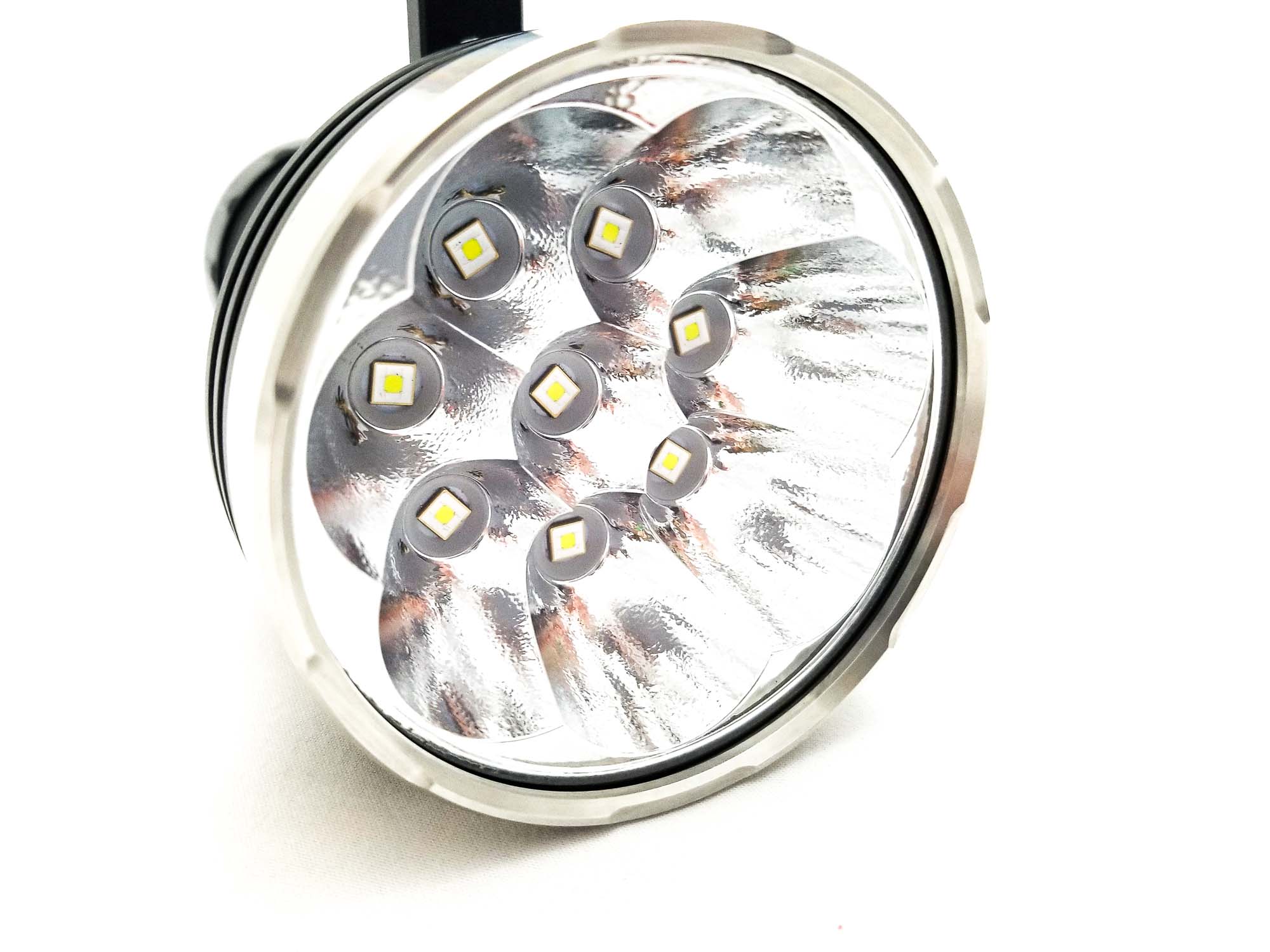
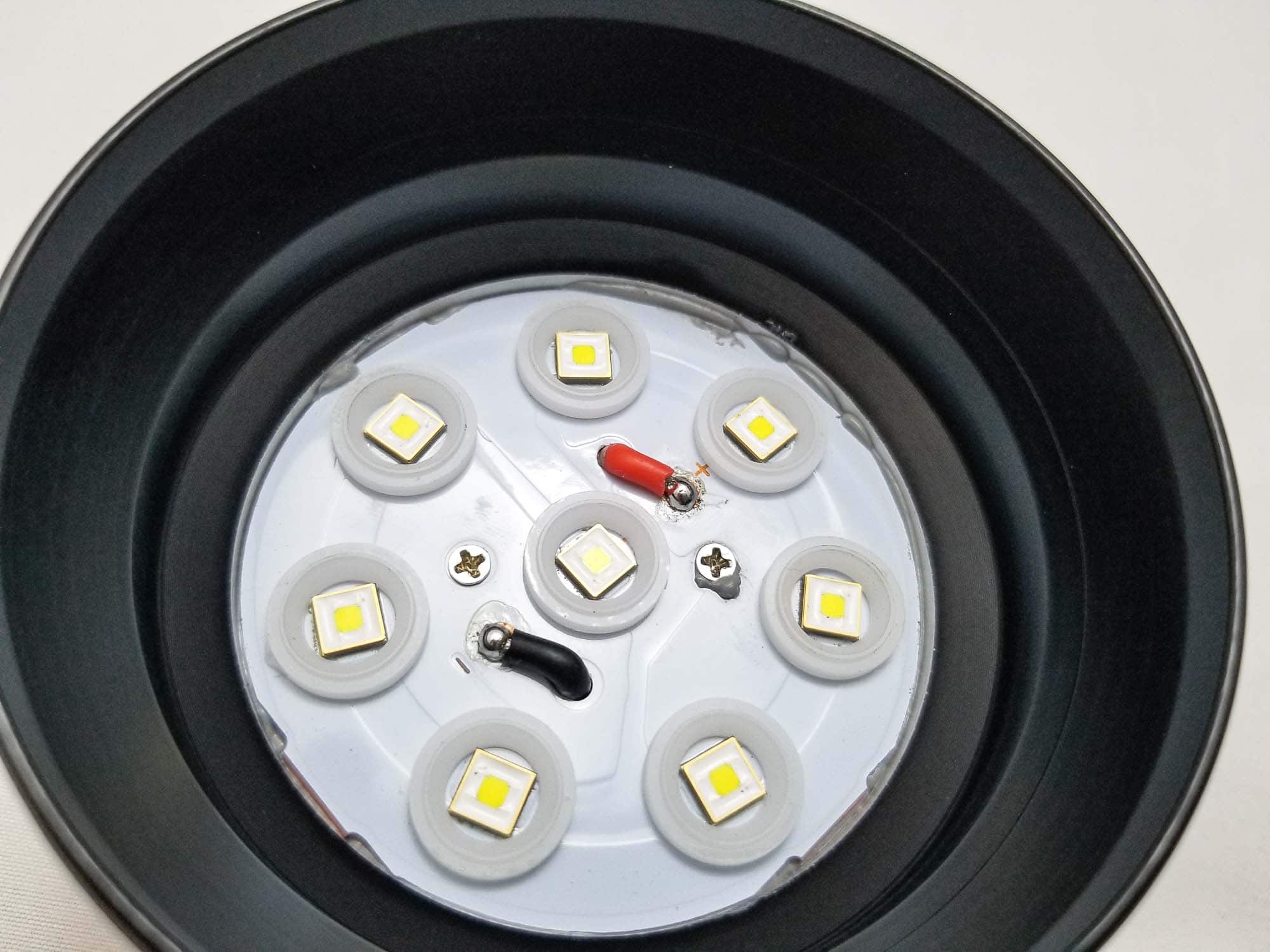
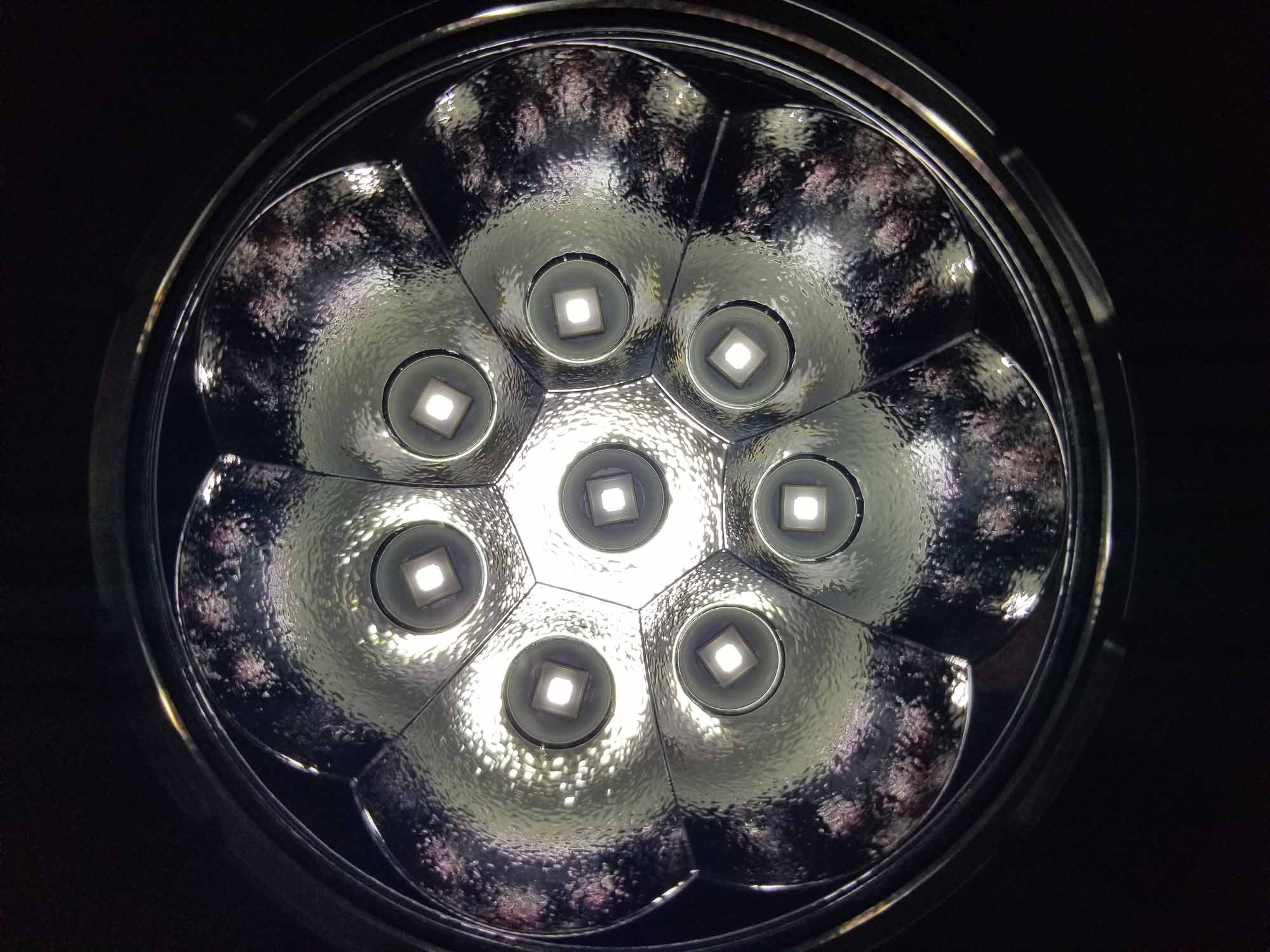
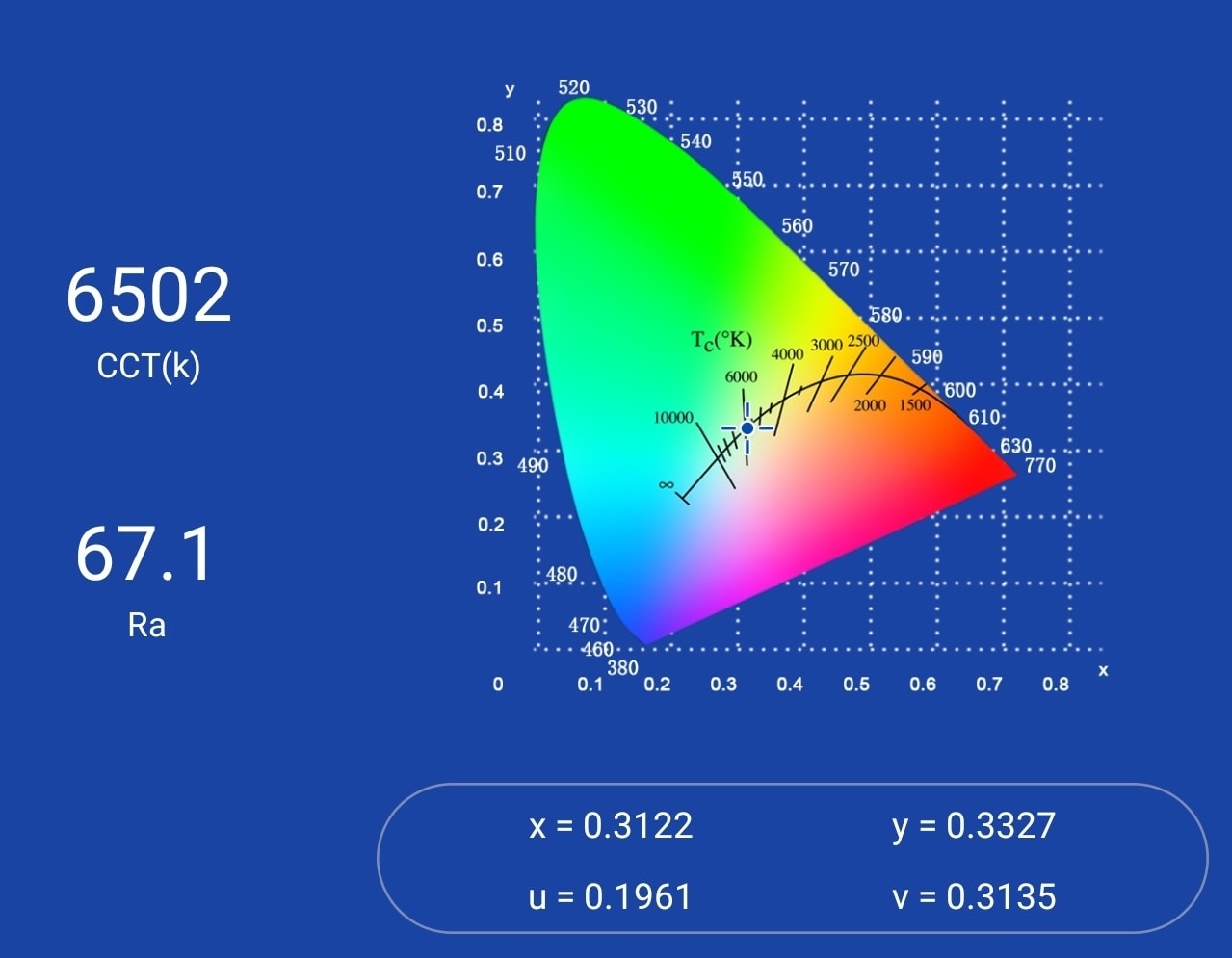
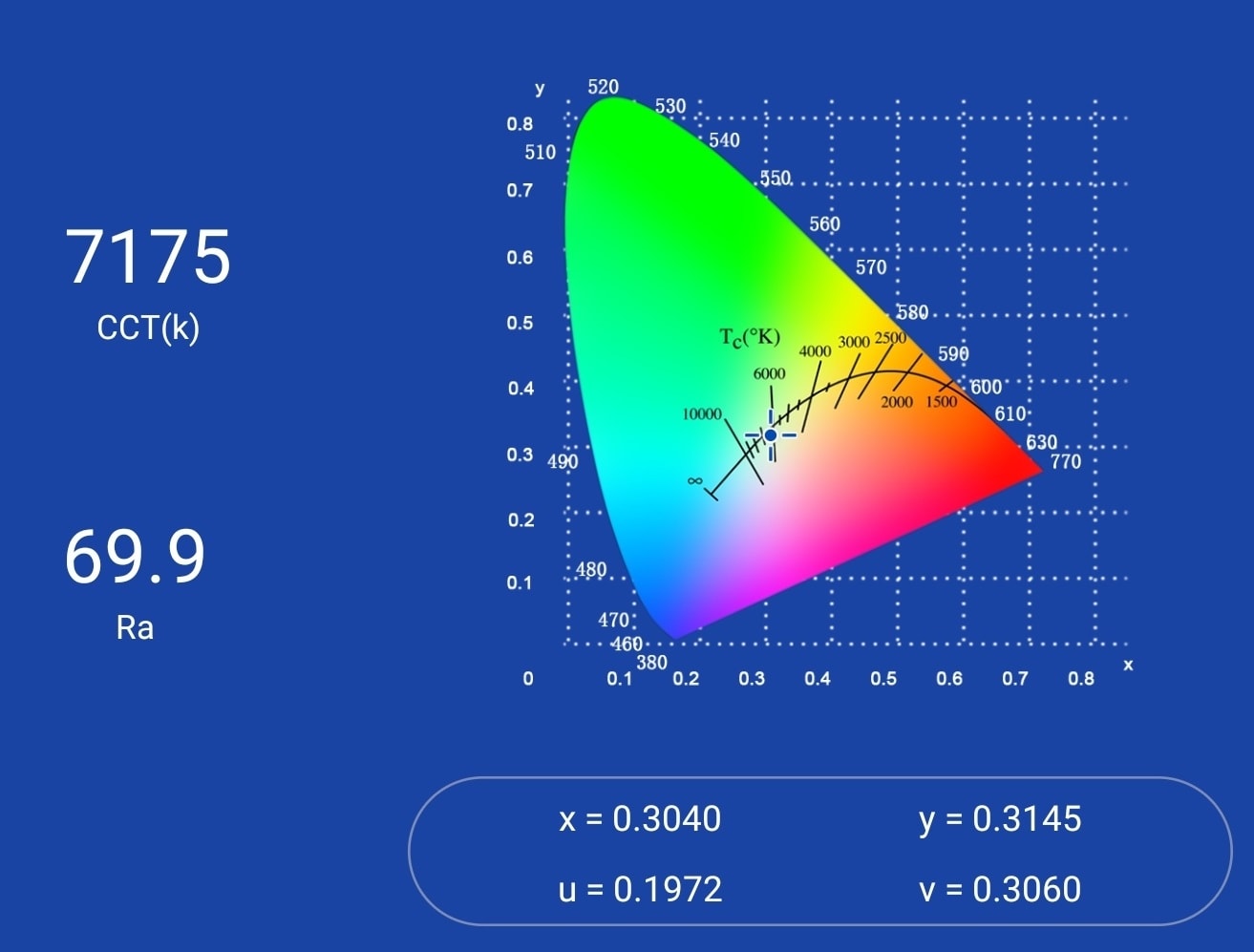
Dimensions and size comparison
Dimensions:
| Dimension | Millimeters | Inches |
|---|---|---|
| Length | 135 | 5.3 |
| Head diameter | 80 | 3.1 |
| Body diameter | 51 | 2 |
Weight:
| Weight | Grams | Oz. |
|---|---|---|
| Without battery with handle: | 541 | 19 |
| With 3 Molicel P42A batteries with handle | 758 | 26 |
| Without batteries, no handle | 508 | 17.9 |
| With batteries, no handle | 706 | 24.8 |
Flashlight size comparison with its competition
I compared the DM80 to some other high output flashlights and long-throw lights.
Group 1: Amutorch DM80, Nightwatch NS59v1, Haikelite HK90
Group 2: Amutorch DM80, Sofirn SP36 Pro, Fenix LR80R
Group 3: Amutorch DM80, Wurkkos TS32, Haikelite HT90
Group 4: Amutorch DM90, Amutorch DM80
Group 5: reflectors left to right: Amutorch DM80, Wurkkos TS32, Nightwatch NS59v1, Sofirn SP36 Pro
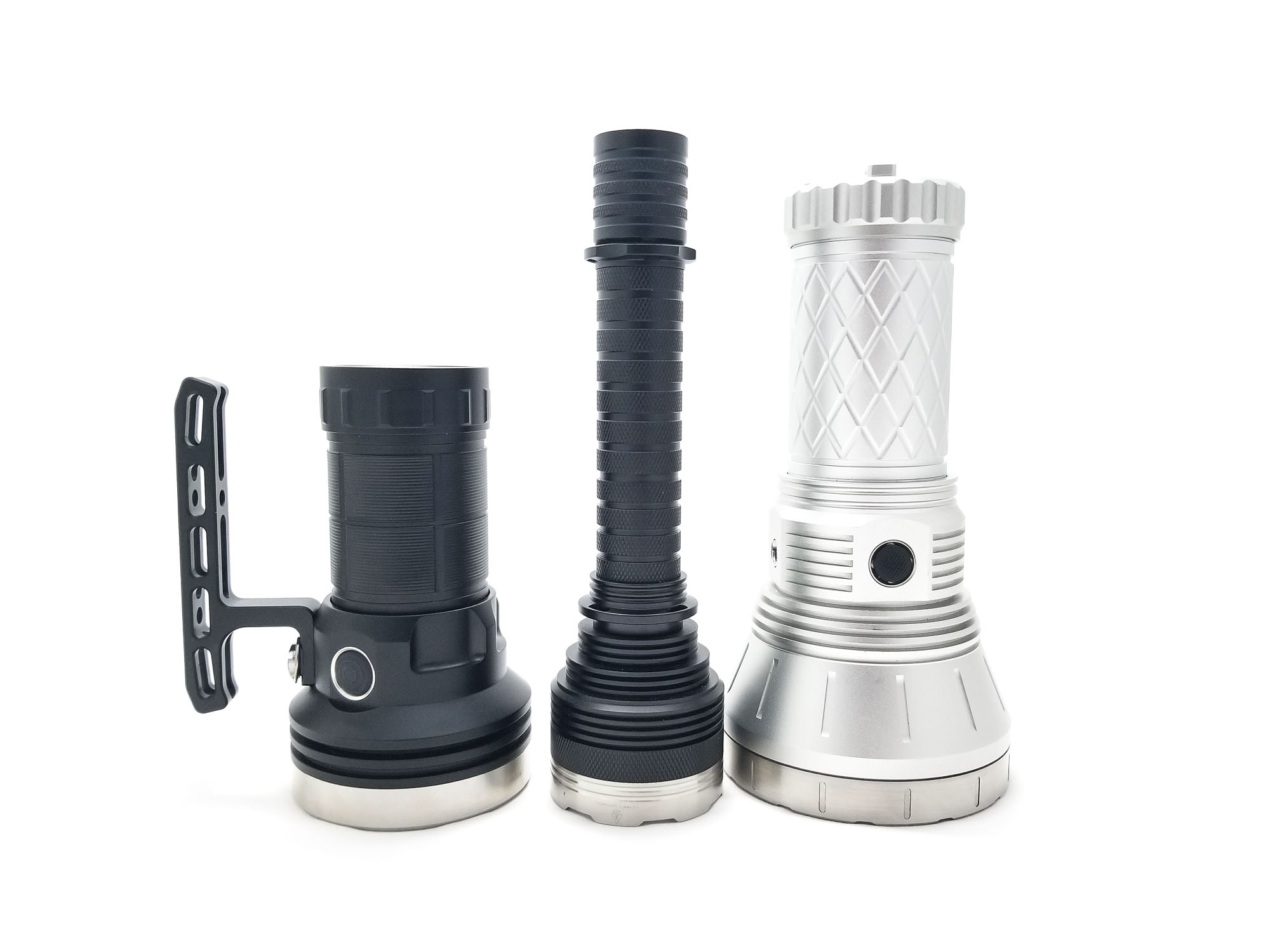
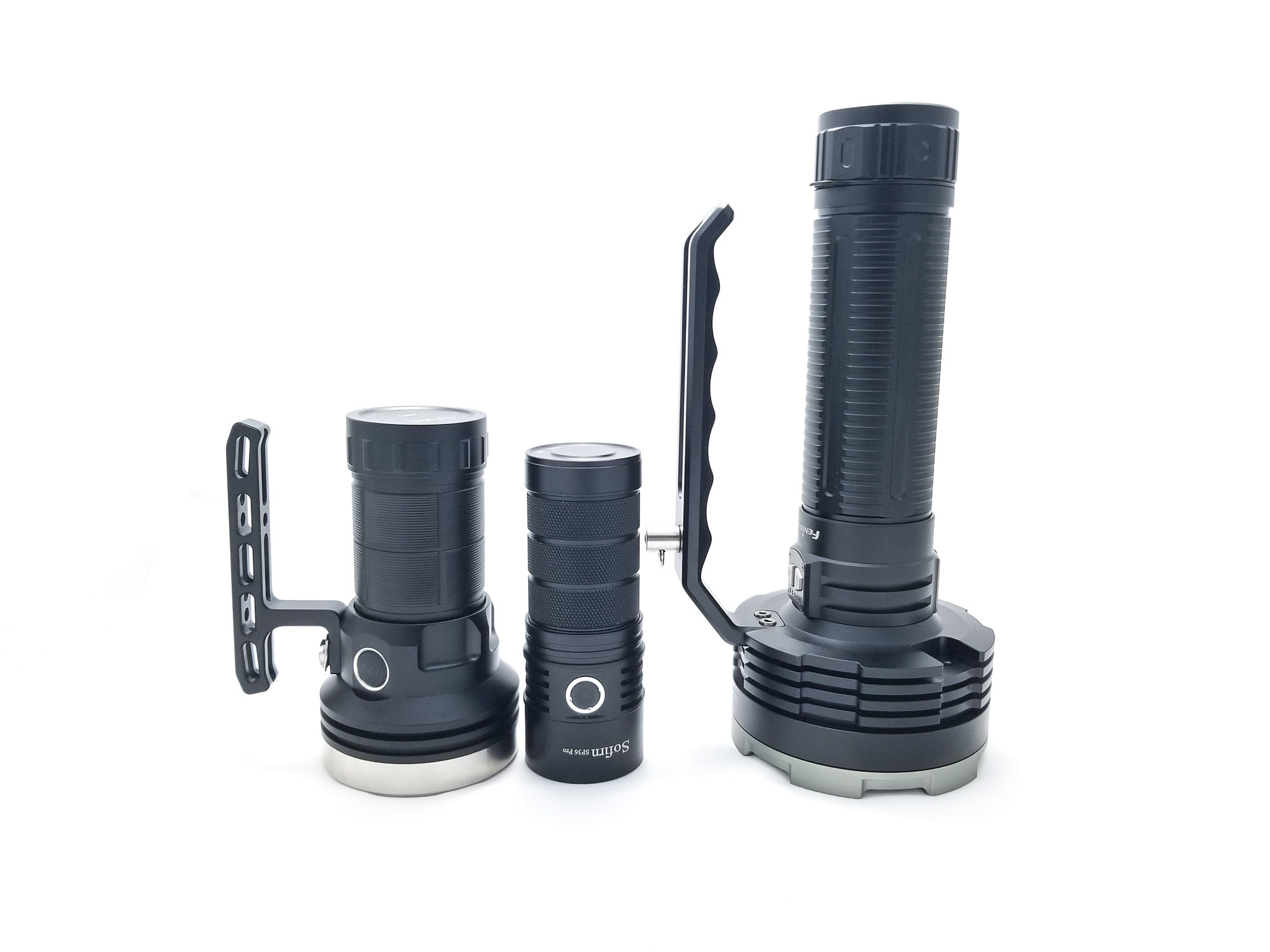
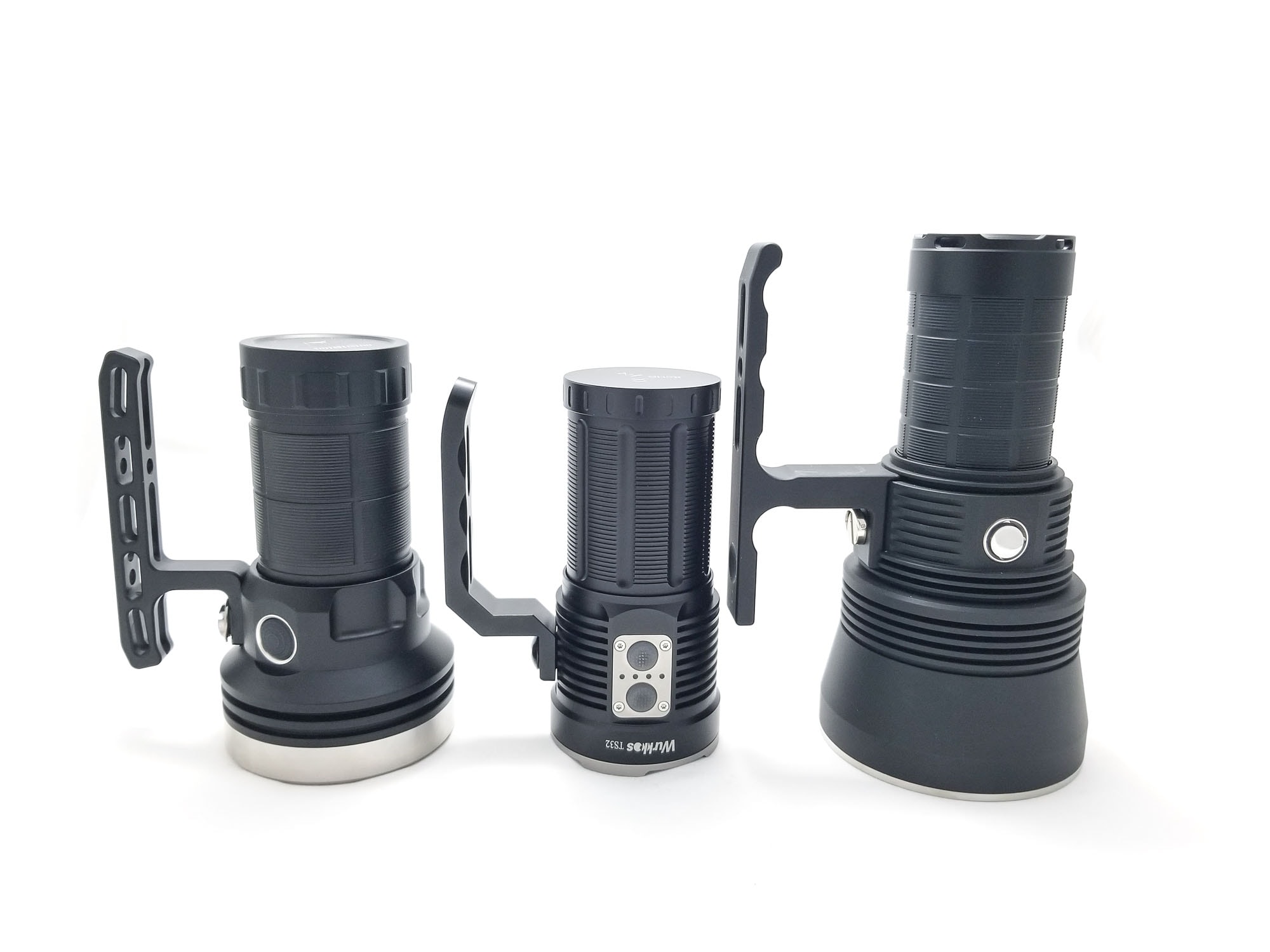
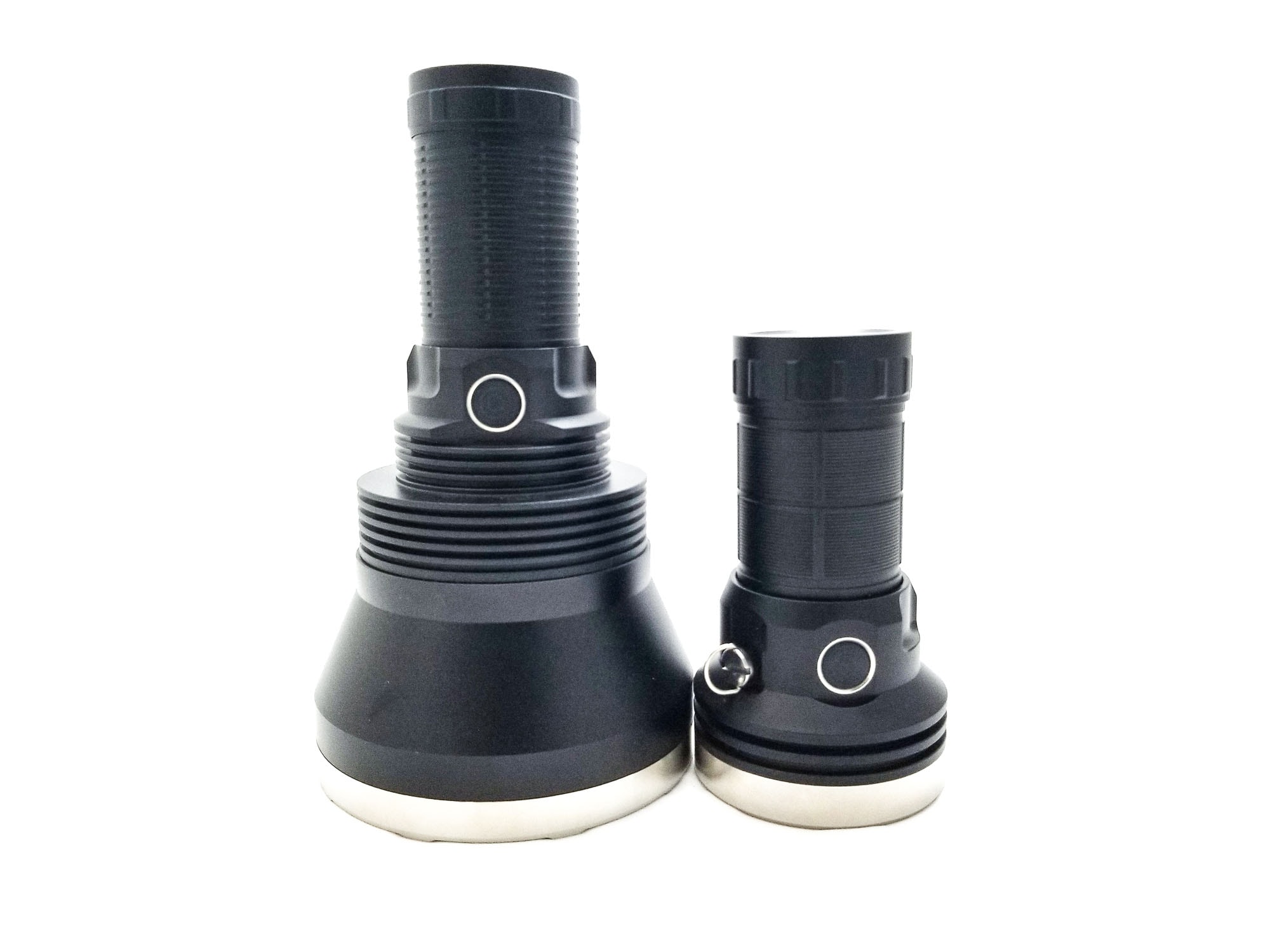
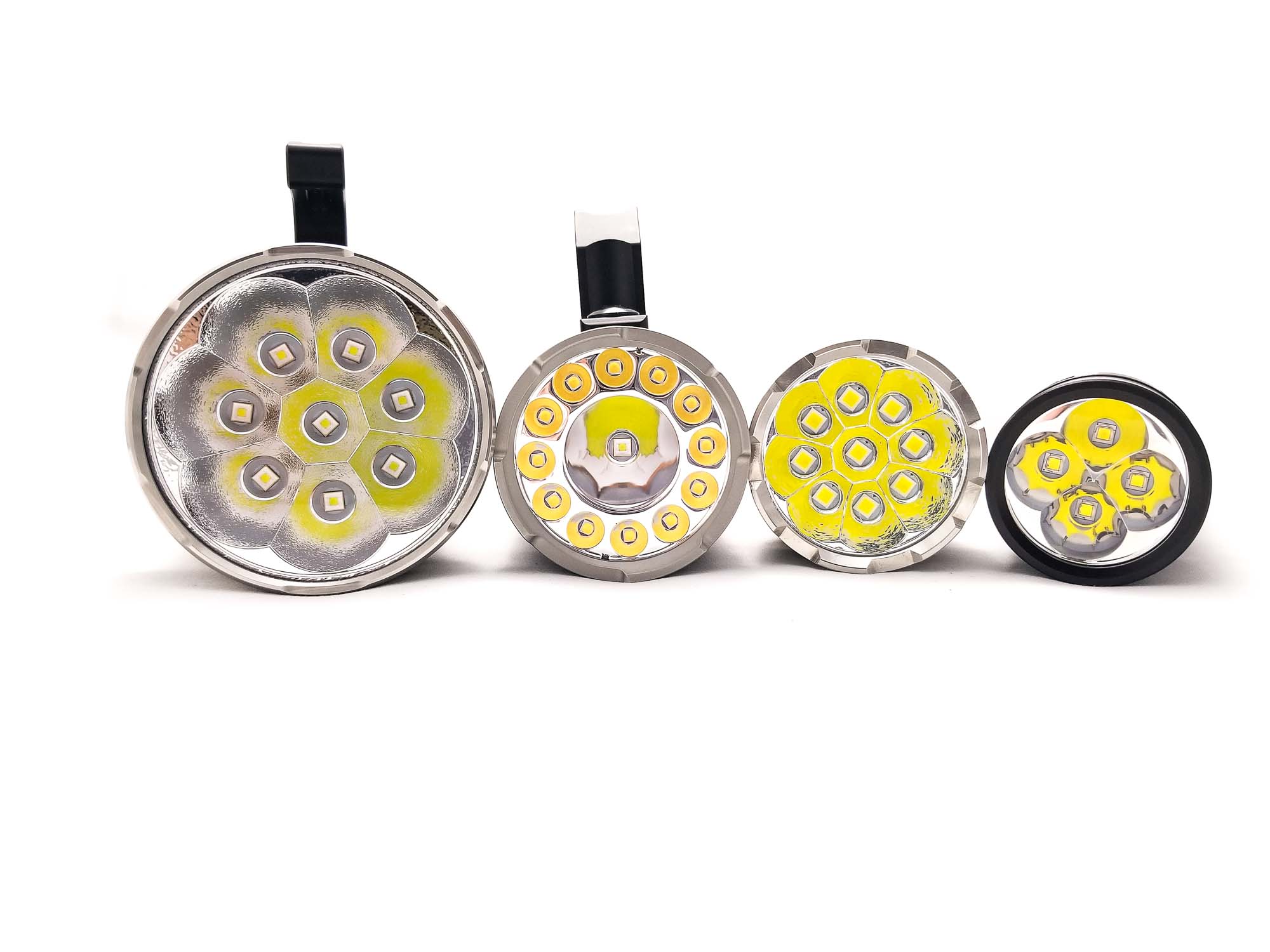
Driver & User Interface:
It seems as if Amutorch has enlisted the DM90 driver for duty on the DM80 which also uses a 3*21700 series battery carrier. Since the SFT-40-W Vf is 3 volts, it needs to be stepped down to keep the emitters from dying, so that means there’s a high output buck driver in there. Buck drivers are much more efficient and supply constant current and voltage to the LED for linear output. The downside is they’re much more expensive than a FET driver, so to see one in a budget light is awesome.
The UI is a simple one-click off, one-click on, 4 modes plus Turbo and a single Strobe. It’s nearly identical to the DM90 and XT series, incorporating smooth and stepped ramping features.
Available modes: Eco, Low, Mid, High, Turbo
Available blinky modes: Strobe
User interface:
From OFF:
- Single click: Turns on in Stepped Ramp Mode
- Click and hold: Turns on in Smooth Ramp Mode
- Double click: Turbo
- Triple click: Strobe
From ON:
- Single click In Smooth Ramp Mode: Turns off
- Single click In Stepped Ramp Mode: Changes modes E-L-M-H
- Click and hold in Stepped Ramp Mode: Ramps brightness up. Releasing and pressing and holding again ramps down.
- Double click: Turbo
- Triple click: Strobe
Mode memory
- Memorizes the last used mode for smooth/stepped ramping. Turbo and Strobe are not memorized.
Shortcuts:
- Double click for Turbo
Low voltage warning:
- Yes. The switch LEDs change color based on the battery state. Green is 100%-50%, orange 50% to 20%, and 20% and under the switch LED turns red. The manual says the light itself will indicate LVP.
Strobe/blinkies
- Strobe
Lock-out mode:
- Yes, the electronic lockout is accessed with 4 clicks from off. The light will blink in low mode and the switch LEDs blink red when the switch is pressed. Repeat to unlock. The switch LEDs will blink green and the light will blink in Low to acknowledge.
Shortcuts:
- To Turbo: Double click from on or off
- To Strobe: Triple click from on or off
- To Eco mode: Press and hold from off
PWM
- None
Additional info on the UI: Although slightly different from the DM90 UI and XT series UI, there’s a lot of continuity between them. The 900 Lumen Low mode and 280 Lumen Eco mode are neither low nor eco, but this is a high-output light, not an EDC piece. The mode spacing isn’t terrible either. However, the smooth ramping quirks remain. From bottom to top of the ramp takes a whole 5.5 seconds. Anduril takes about 3.4 seconds, and it isn’t very linear. The ramp top and bottom are indicated by a slow double blink. Again, the smooth ramp and stepped ramp mode memories don’t commingle. It will start in whatever mode was last used when you used the smooth ramping, and the same is true for the stepped modes. Starting in a stepped mode will default to the last-used stepped mode, and vice versa with the smooth ramping.
Batteries & Charging
As previously mentioned, the DM80 adopts the DM90’s three, 21700 battery configuration. The batteries are arranged in series within the removable carrier for a total of 12.6 volts fully charged, 9.6 volts nominal. The advantage to having three 21700s in series as opposed to running in parallel is you can run the light off a buck driver, which lowers the input current relative to output current. The downside is you need to use identical, matched batteries to get the most out of this setup. The batteries must be the same age, always used together, and of the same brand, capacity, and discharge capacity. Mismatched batteries can significantly lower both output and battery life, and can cause battery damage.
The carrier incorporates USB type C charging, so you don’t need a standalone charger anymore. The charging circuit is situated on the battery carrier a-la WildTrail WT90, and unlike the WT90, it can be accessed by unscrewing the tailcap instead of removing it completely, which is nice. There’s a single LED indicator on the top that’s either green/blue for charged or red for charging. No charging current specs are listed, but on a PD charger I get about 5 volts 2 amps on a USB to C cable and a C to C cable. This is pretty slow now that some lights are using 18 W and higher charging speeds. I’m not too concerned, since these are series cells and the total capacity is equal to a single cell. The power bank is the same, speed-wise, around 5 volts 2 amps. You are limited to a type C to type C cable with the power bank.
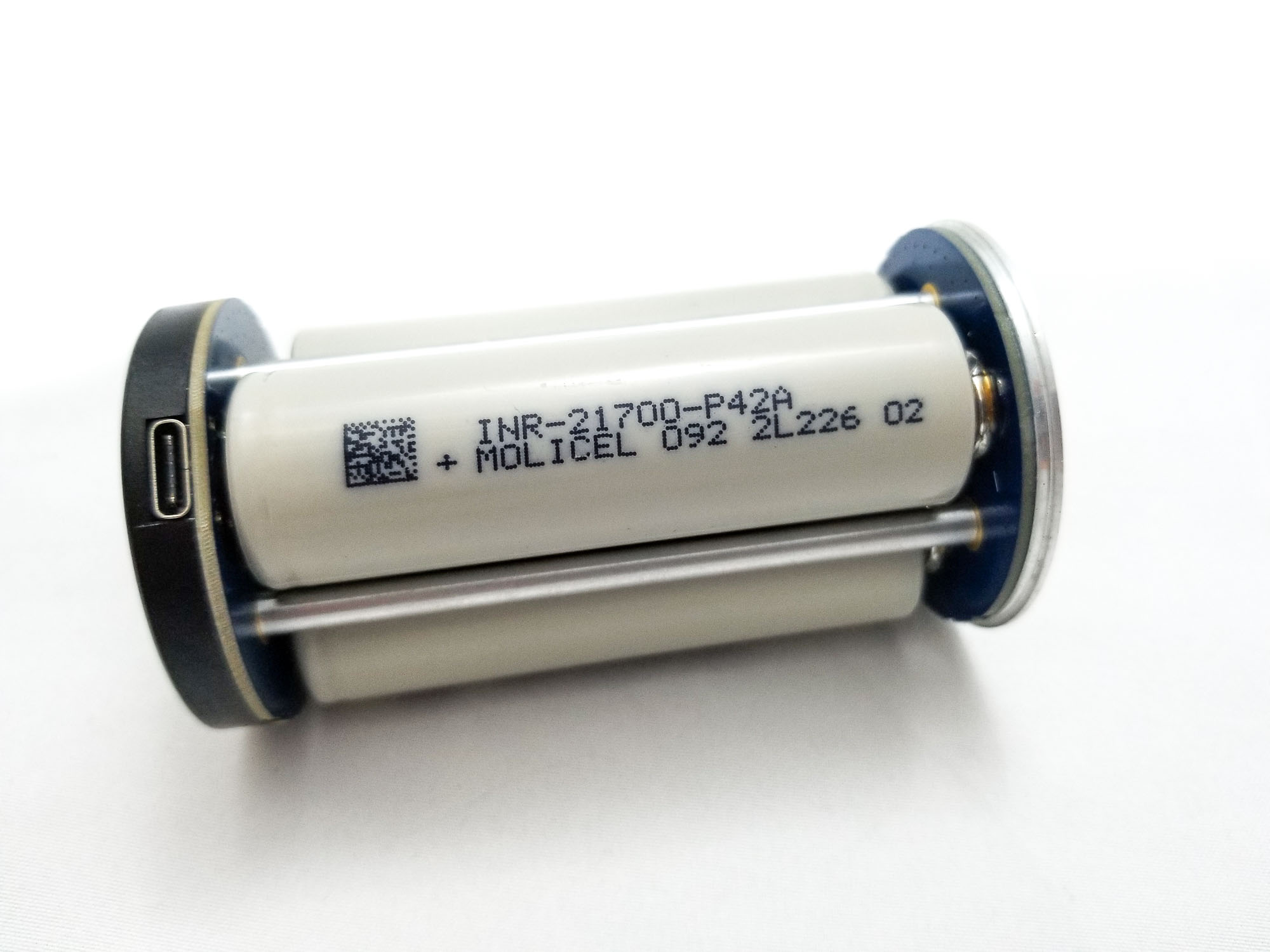
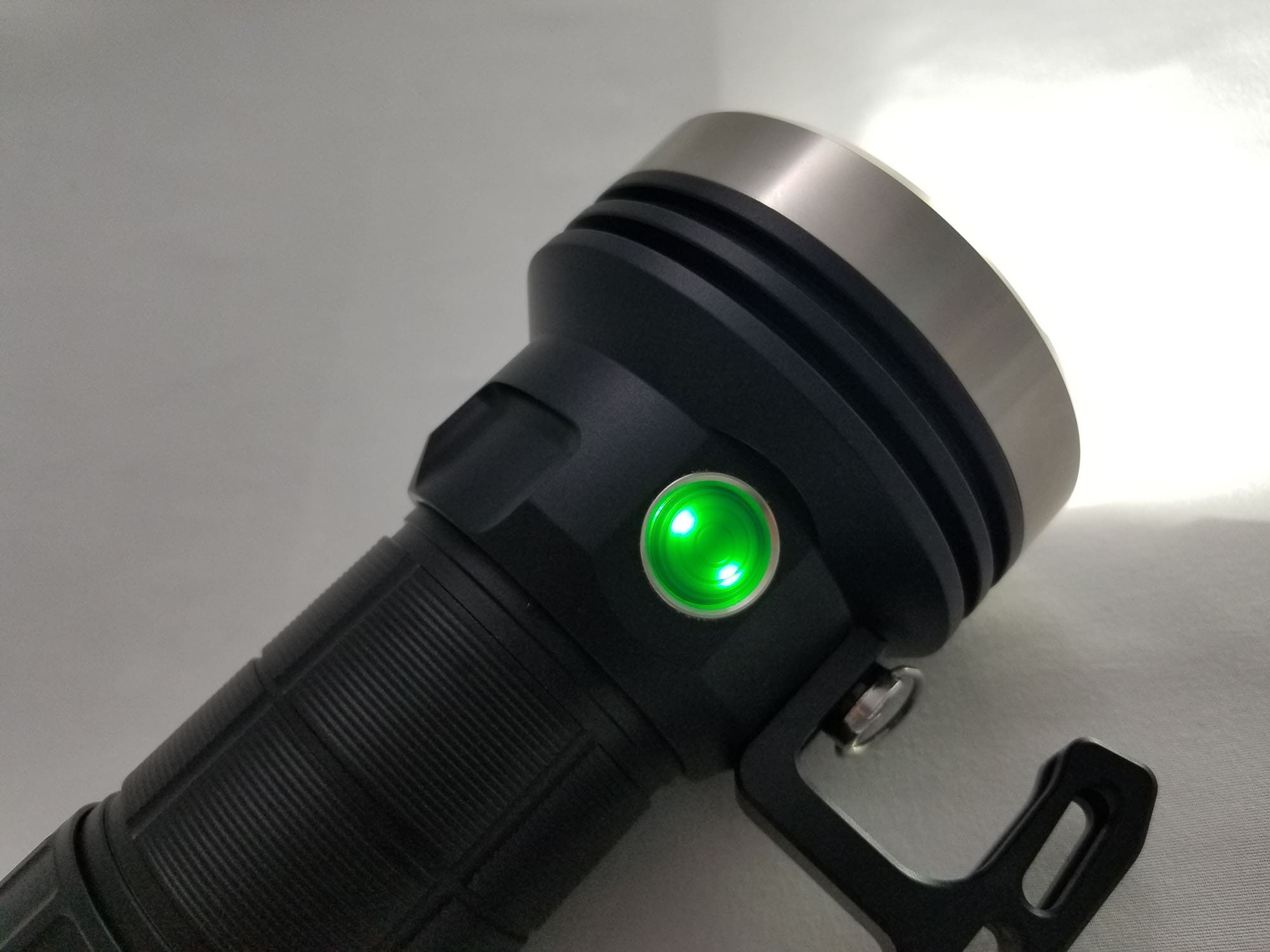
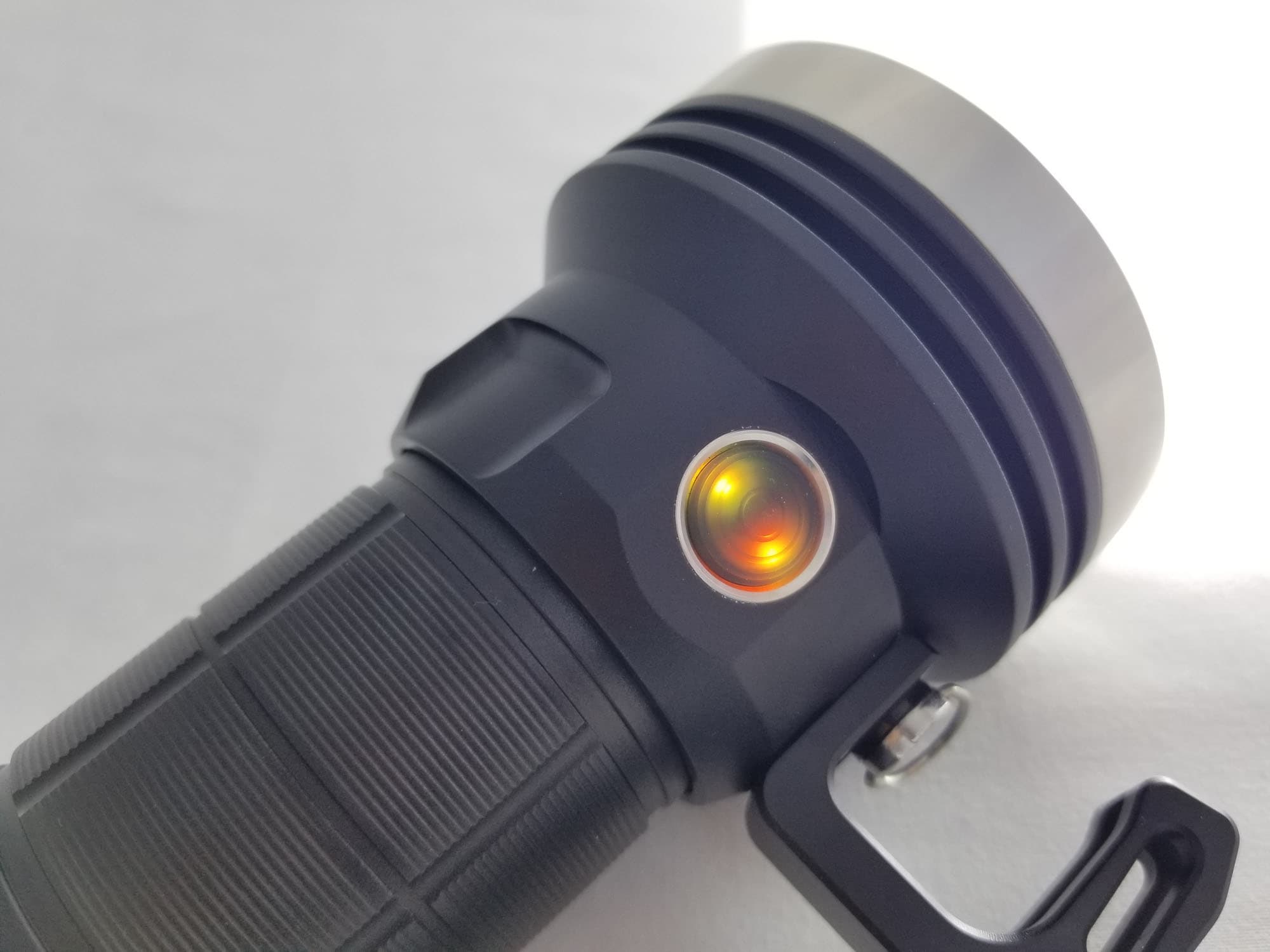
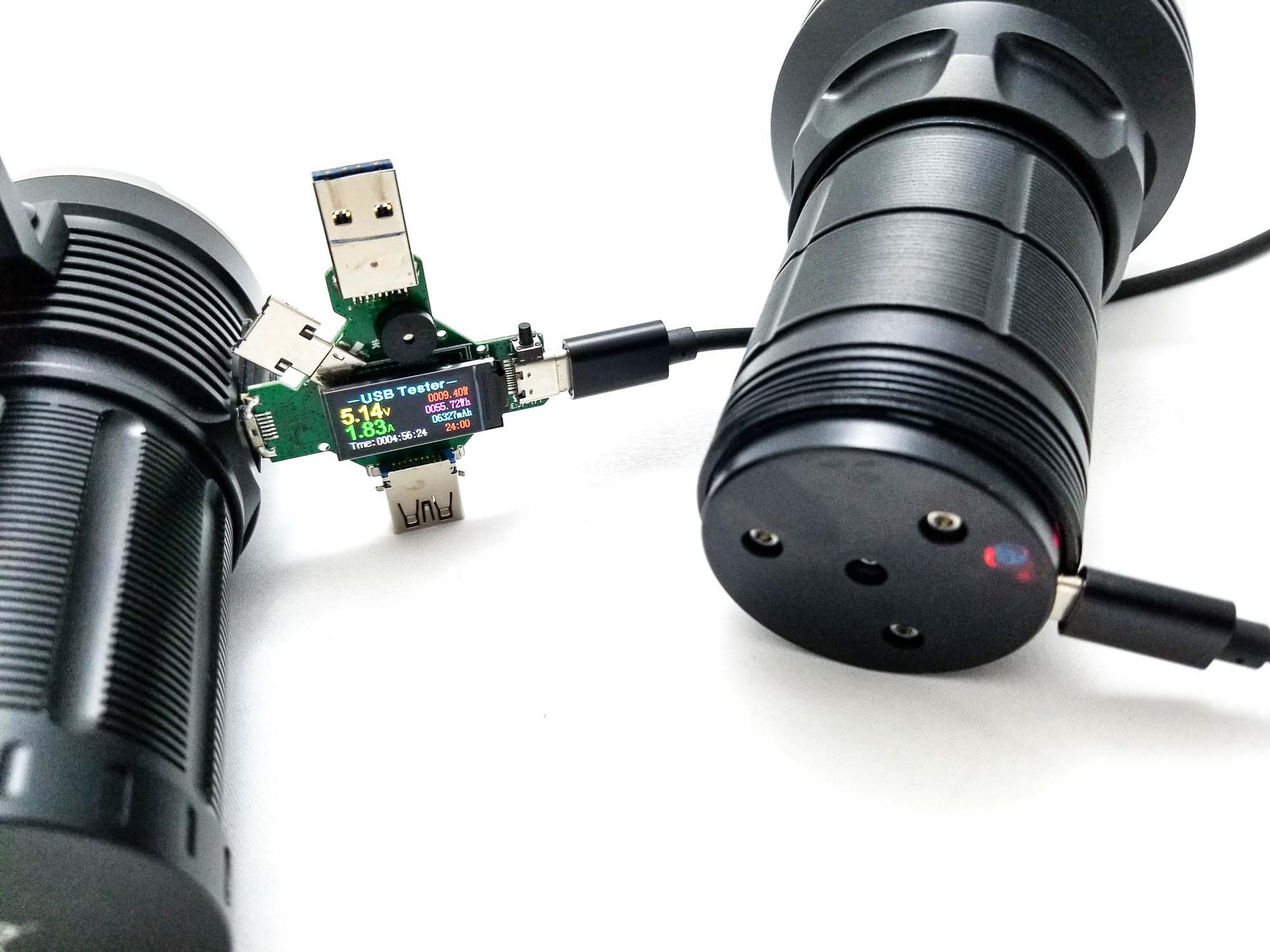
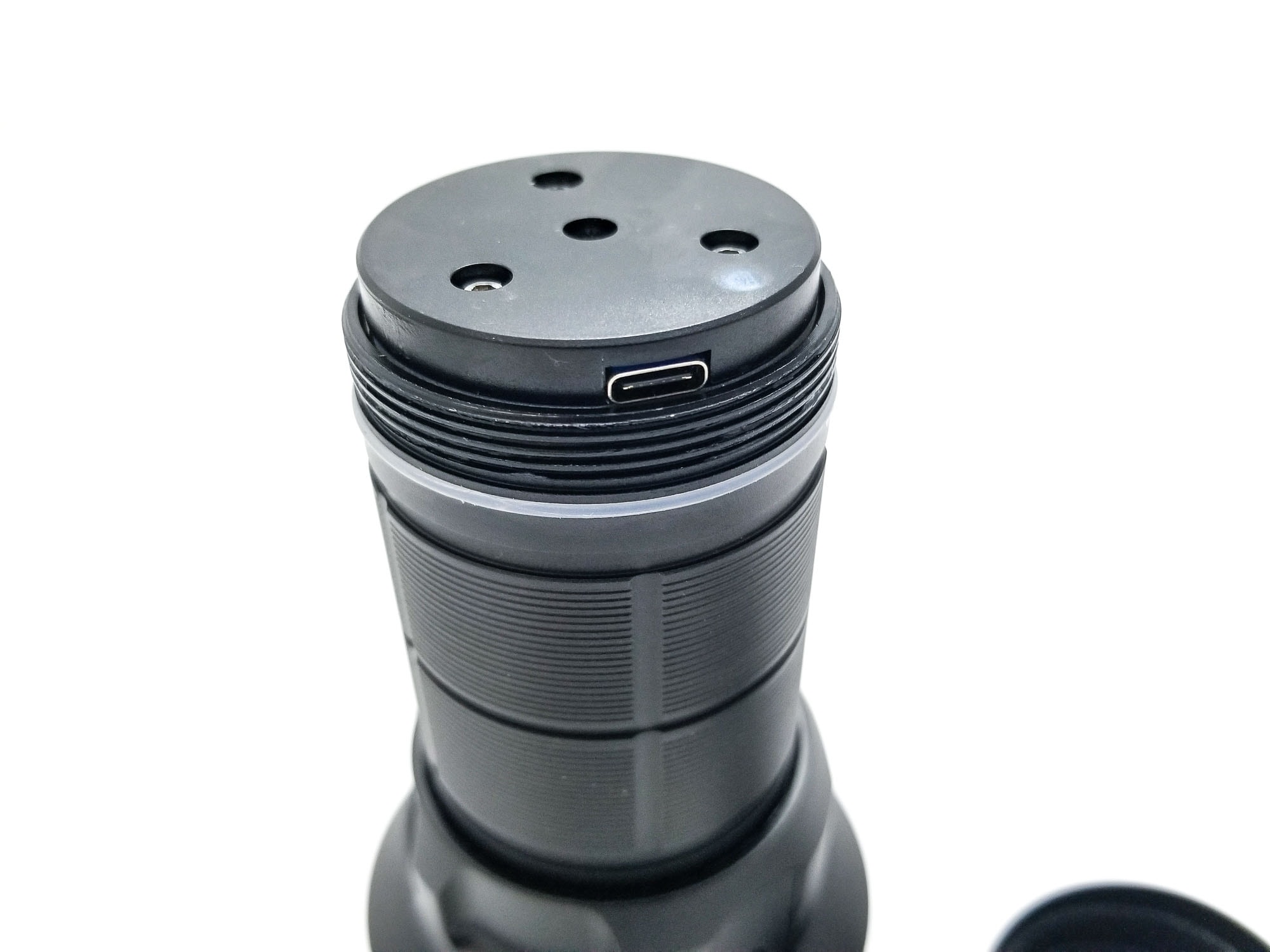
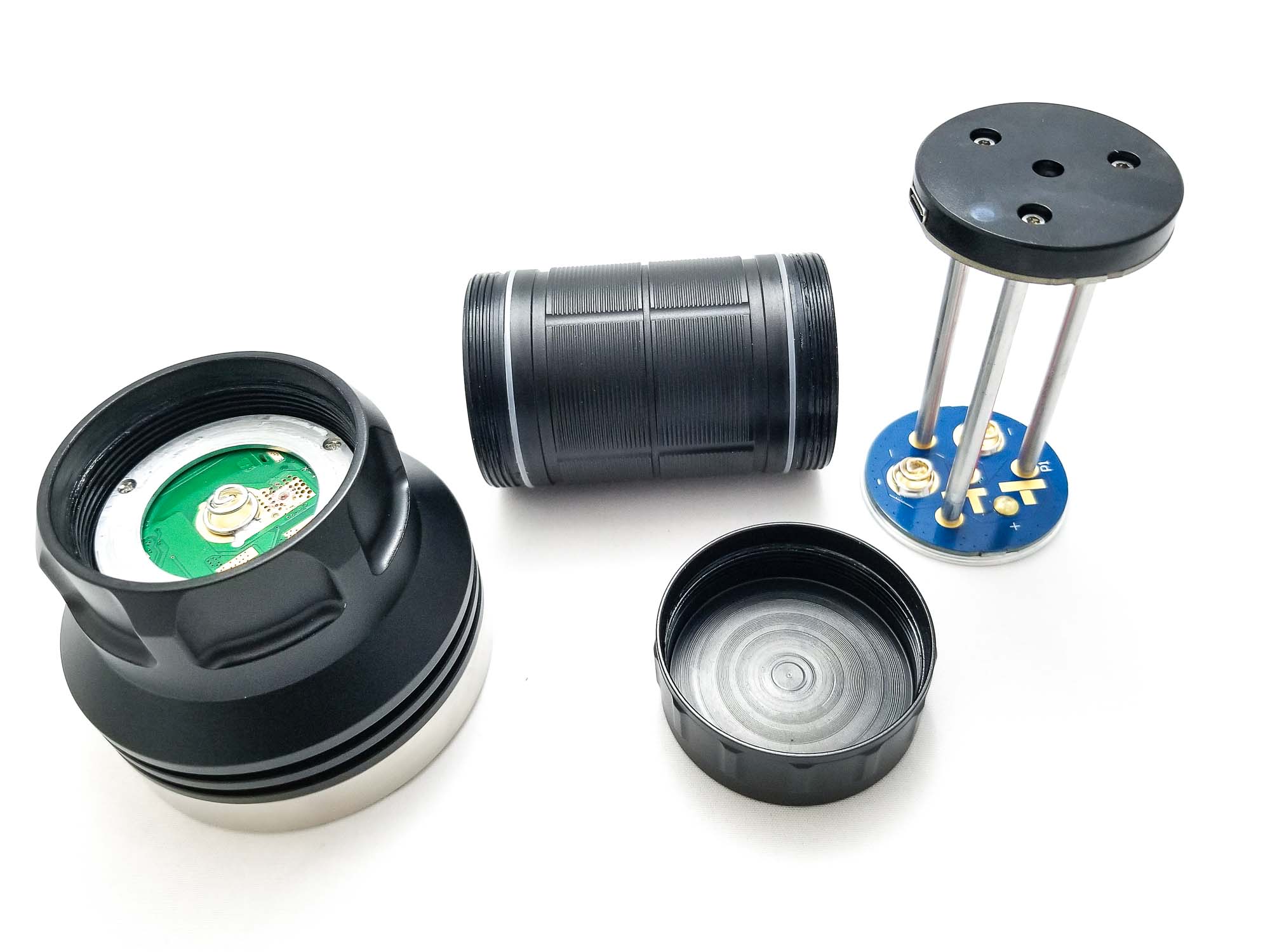
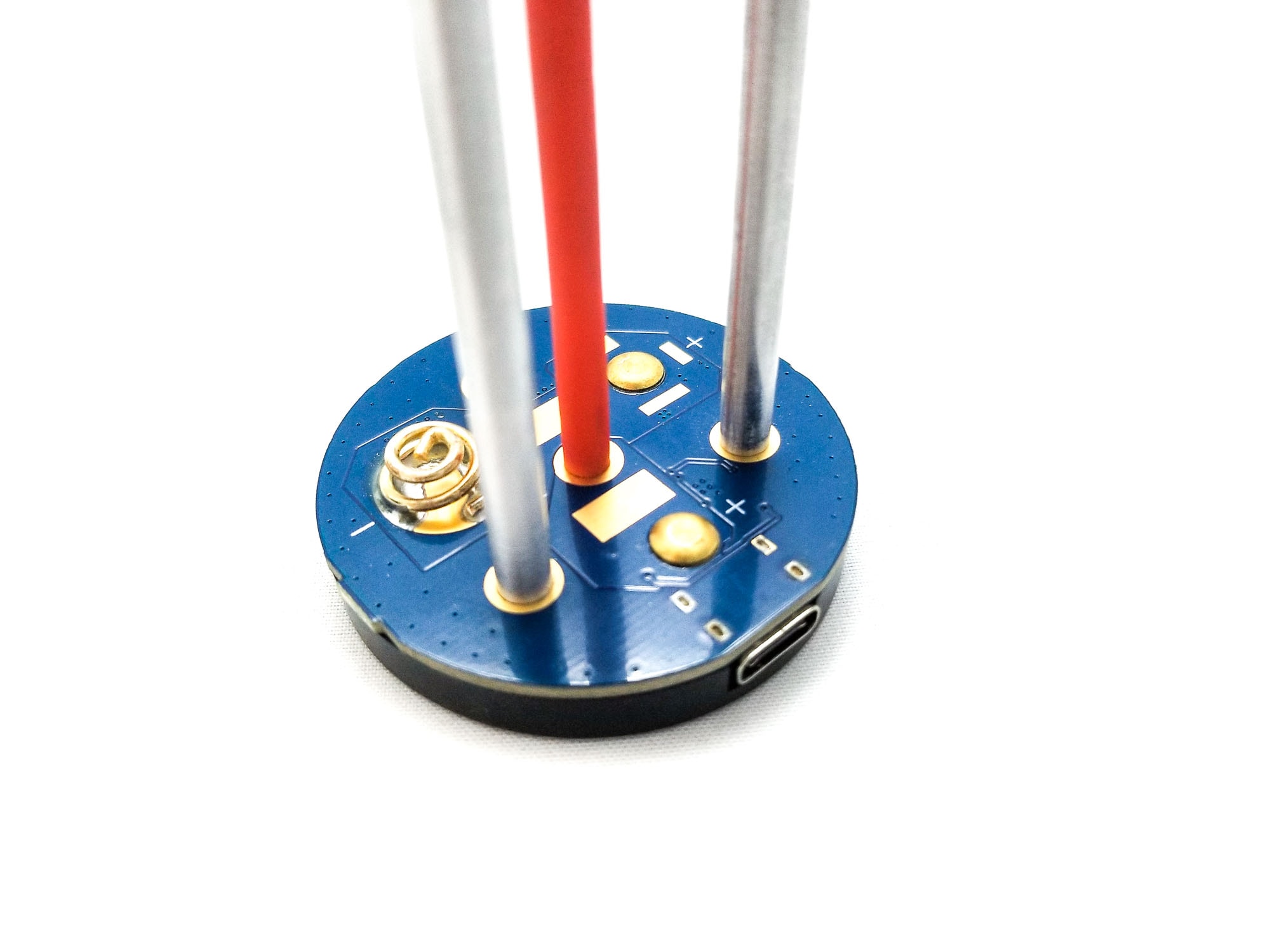
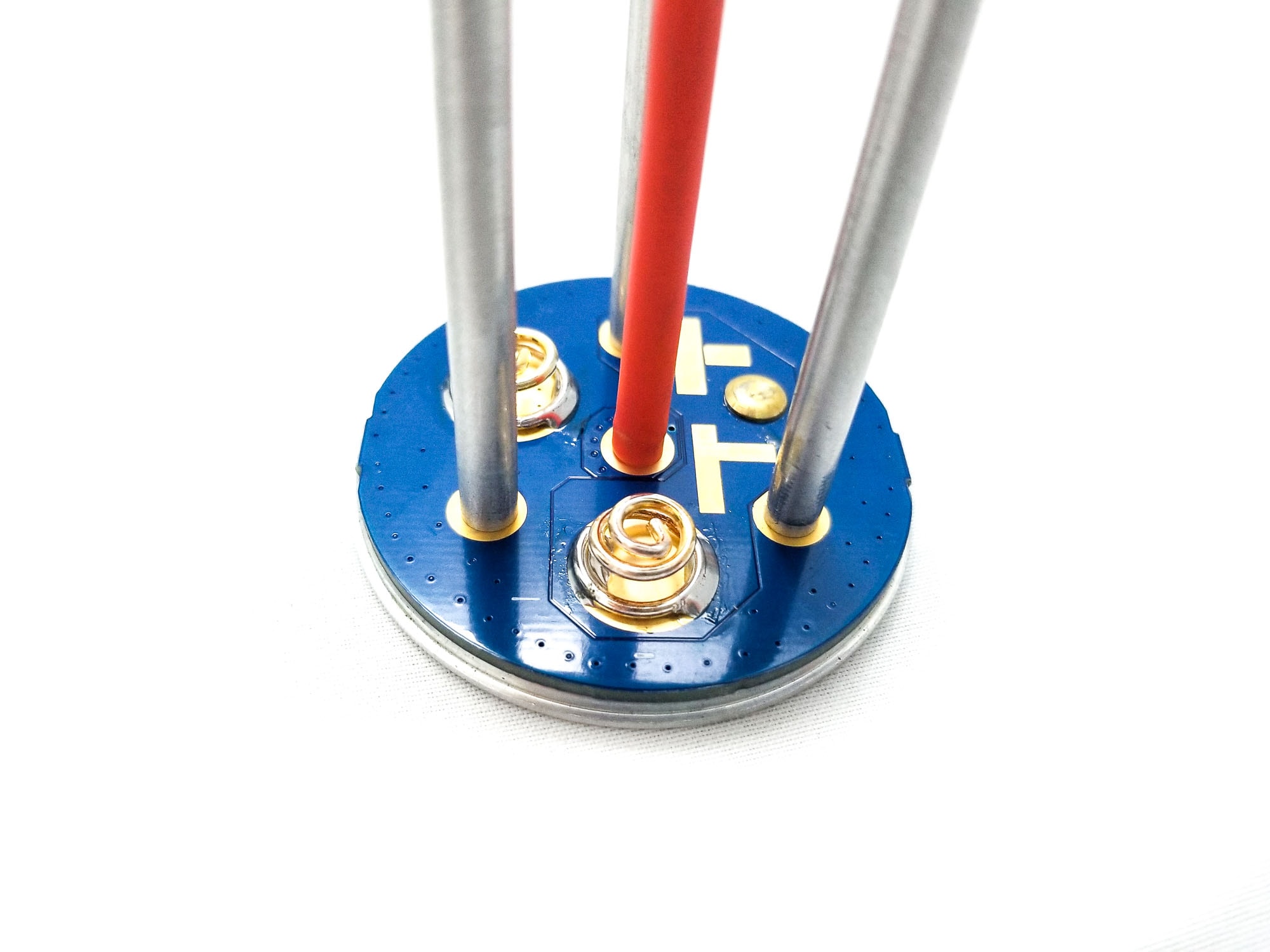
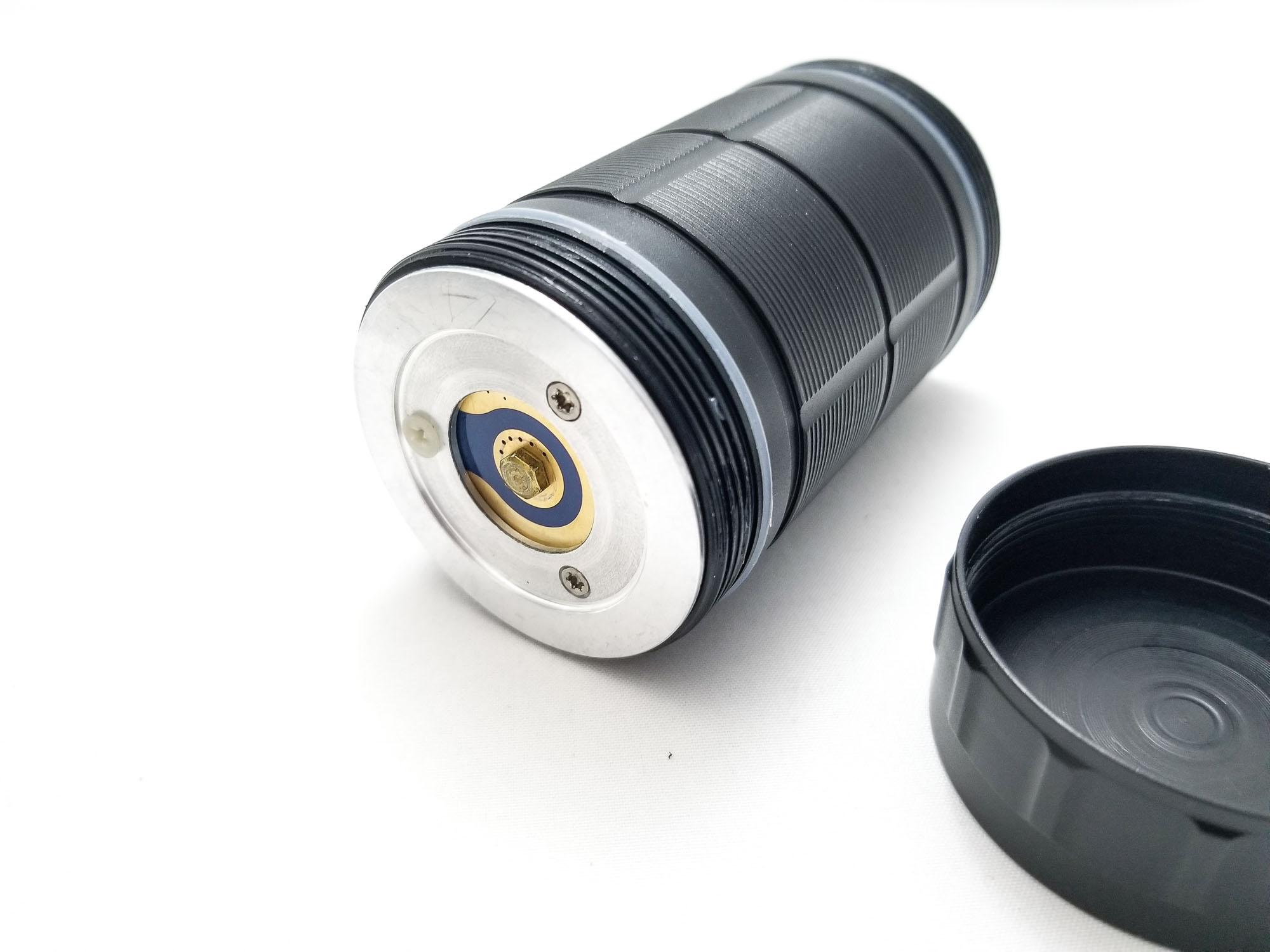
Performance test
Lumen measurements
Lumens are measured using my home made 50 cm integrating sphere, and I use a Digi-Sense 20250-00 datalogging luxmeter. The sphere has been calibrated using a Convoy S2+ calibrated to 260 Lumens and is accurate within 10% of actual output. All measurements taken at 30 seconds using 3, fully chargedMolicel P42A 4200 mAh batteries. No amp measurements this time.
| Mode | Specified | turn on | 30 sec | 10 minutes |
|---|---|---|---|---|
| Low | 900 | 467 lm | 467 lm | 467 lm |
| Mid | 2100 | 1,845 lm | 1,845 lm | 1,820 lm |
| High | 4000 | 3,456 lm | 3,432 lm | 3,309 lm |
| Turbo | 18,000 | 15,498 lm | 13,653 lm | 1,968 lm |
Parasitic drain:
- N/A
Turbo is down from the 18,000 advertised, but that’s okay since 15,000+ Lumens is fine by me! The output is nicely regulated too. Turbo is supposed to drop to Mid mode after 2 minutes, but it’s coming down after about 60 seconds to around 2000 Lumens. I tested the light with some 30Ts and there was no difference, which makes sense given the current regulated driver.
Battery Life: Runtime graphs
Runtimes are measured using my home made 50 cm integrating sphere, and I use a Digi-Sense 20250-00 datalogging luxmeter. The sphere is calibrated with a Convoy S2+ at 260 Lumens and the figures are within 10% of actual.I tested Low, Mid, High, and Turbo modes using 3, fully charged Molicel P42A 4200 mAh 21700s.
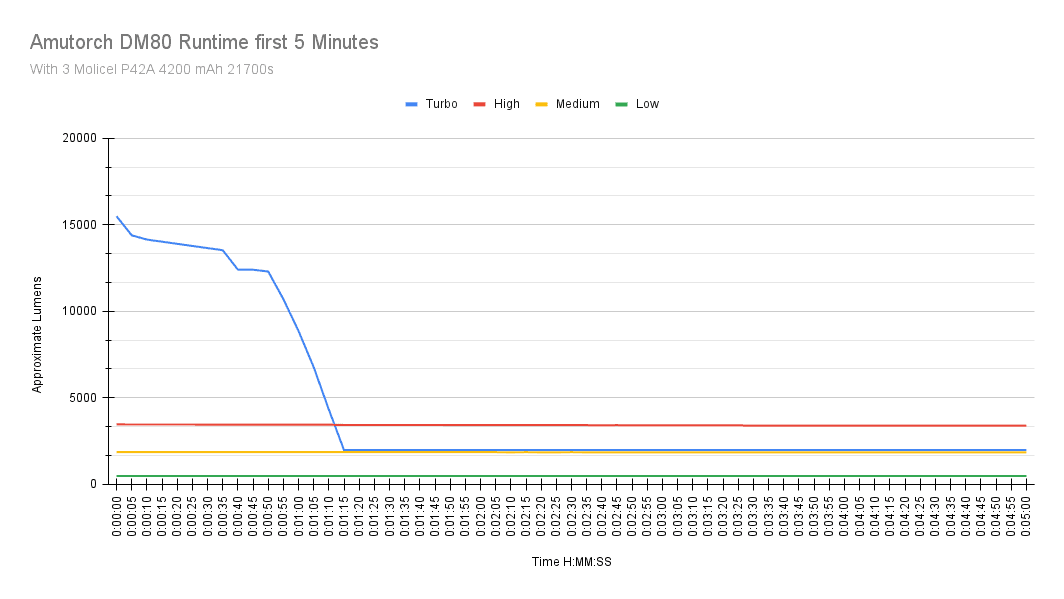
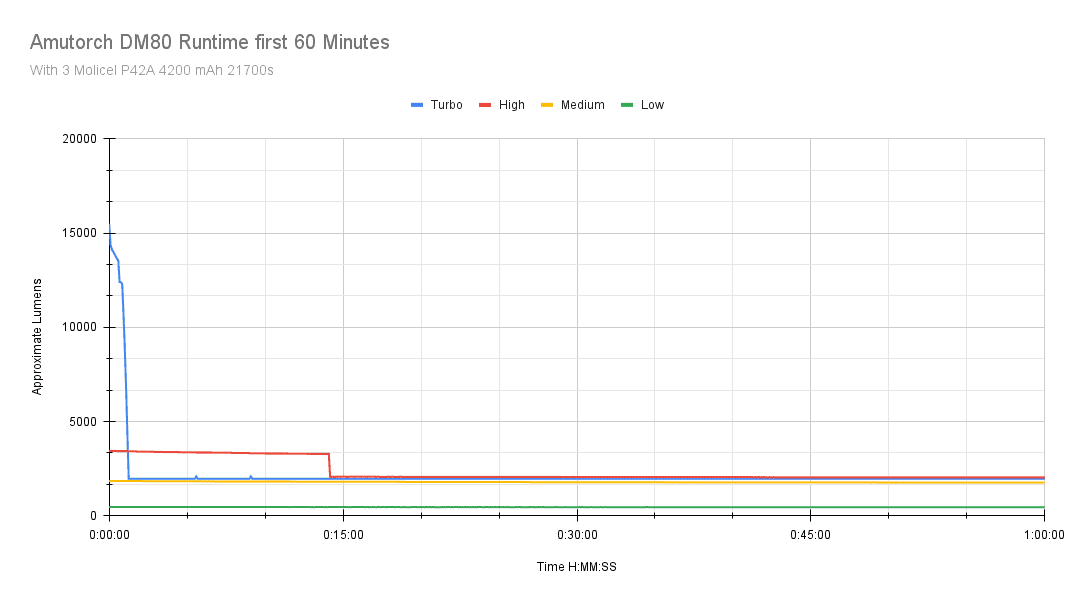
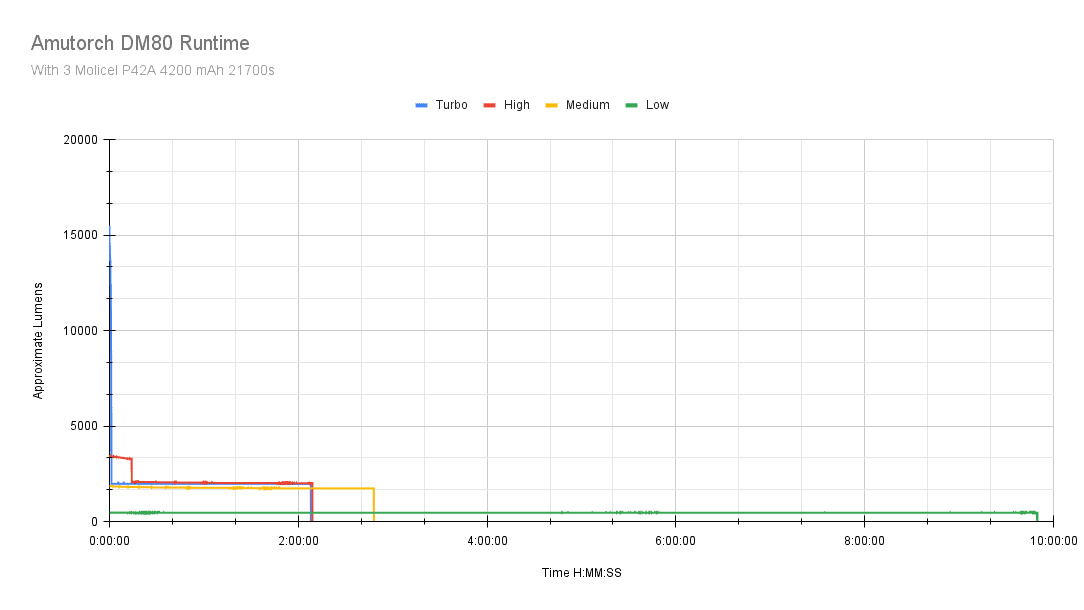
| Mode | Specified | Measured runtime (ANSI) | Time till shut off |
|---|---|---|---|
| Low | 9h30min | 9h 49min | 9h 49min |
| Mid | 3h50min | 2h 48min | 2h 48min |
| High | 2h | 2h 8min | 2h 8min |
| Turbo* | >2h | 2h 7min | 2h 7min |
The buck driver does a great job here, with nicely regulated runtimes, and it’s a near similar performance like I saw with the DM90. No surprises here, and the temperature regulation keeps the temperatures within 60 C on Turbo. The light was comfortable to hold for every runtime without using the handle, although after about an hour on Turbo, the tube was getting a bit warm. The light was usable on every mode except Turbo after each test. The switch LEDs turned red and there was a noticeable double blink when the batteries got low. The light blinked twice about 5-10 minutes before shutting down, which was abrupt. The batteries were sitting at around 2.98 volts after the tests, with 9.1 volts showing at the carrier so LVP works awesome. This is very important with series cells.
ANSI FL1 standards: The runtime is measured until the light drops to 10% of its initial output (30 seconds after turning on). This does not mean that the flashlight is not usable anymore. The last column shows how long the light actually works till it shuts off. If there is a + symbol, it means that the test was stopped at that particular point, but the light was actually still running. This happens on certain occasions, with certain drivers, firmware, or batteries.
Peak beam intensity and beam distance measurements
Throw was measured indoors at 5 meters using the Uni-T UT383S luxmeter. Measurements taken at 30 seconds. I usually measure lights with advertised 1300 meters of throw at 10 meters outdoors, but 5 meters is sufficient for an accurate reading. I used Molicel P42As for the test.
| Mode | Specified | Candela measured | Meters | Yards |
|---|---|---|---|---|
| Low | ? | 14,600 | 242 | 264 |
| Mid | ? | 36,775 | 384 | 419 |
| High | ? | 63,075 | 502 | 549 |
| Turbo | ? | 233,625 cd (284,250 at start) | 946 (1,066 at start) | 1,034 (1,166 at start) |
Amutorch doesn’t list a specific candela figure for the DM80, just a throw figure of 1389 meters (probably on Turbo). I’m coming in way under that, but 1,000 meters at the start is not too shabby for a 80 mm head. Testing with 30Ts made no difference in output.
Extra info: Peak beam distance according to ANSI FL1 standards: The calculated value of distance in meters at which the flashlight produces a light intensity of 0.25 lux. (0.25 lux is about the brightness of a full moon shining on an object).
Beamshots
I compared the DM80 to some other high output, multi-LED long-throw flashlights. Photos taken with my Samsung Note 8. The 95 meter shots with the camera set to 0.3s ISO 200 and 5000K WB. The 950 meter shots used 0.5s ISO 400 and 5000K WB.
Beamshots compared to the following flashlights (at 40 meters):
- Amutorch DM80
- Haikelite HT90
- Haikelite HK90
- Fenix LR80R
- Wuben A1
- Nightwatch NS59v1
Beamshots at 950 meters:
- Amutorch DM80
- Haikelite HT90
- Haikelite HK90

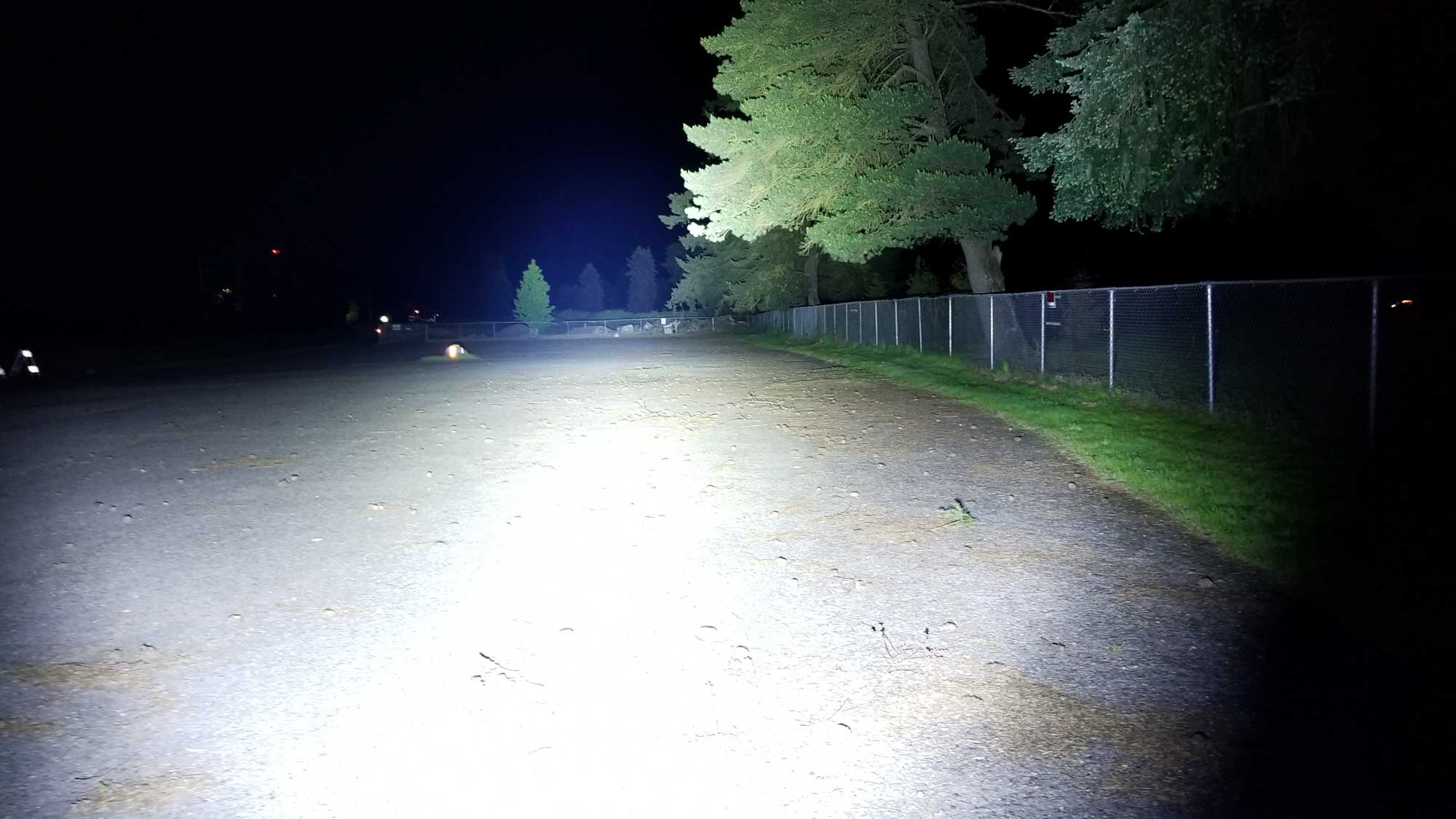
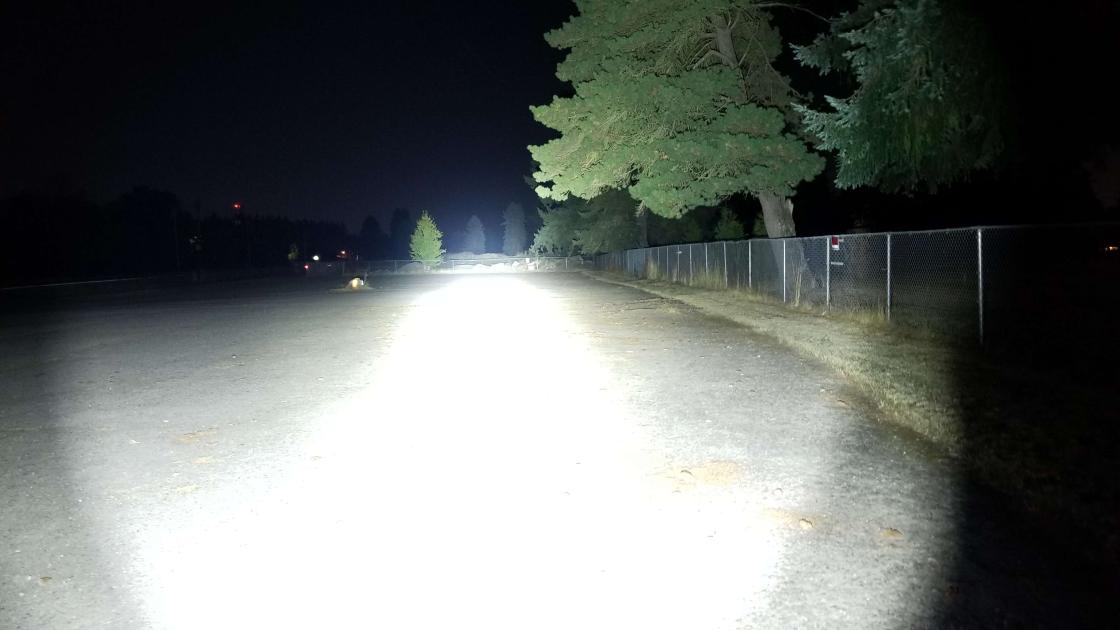
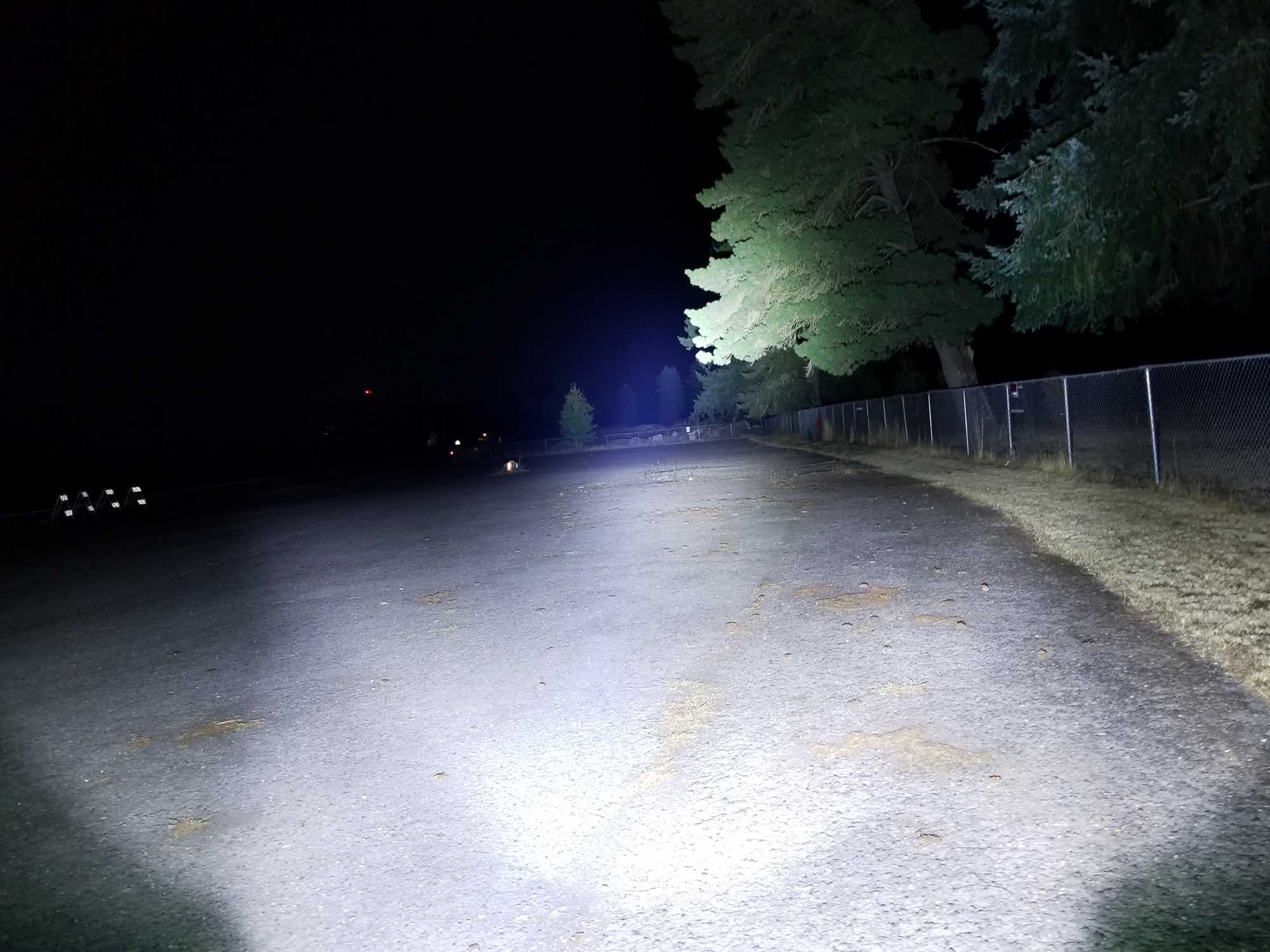
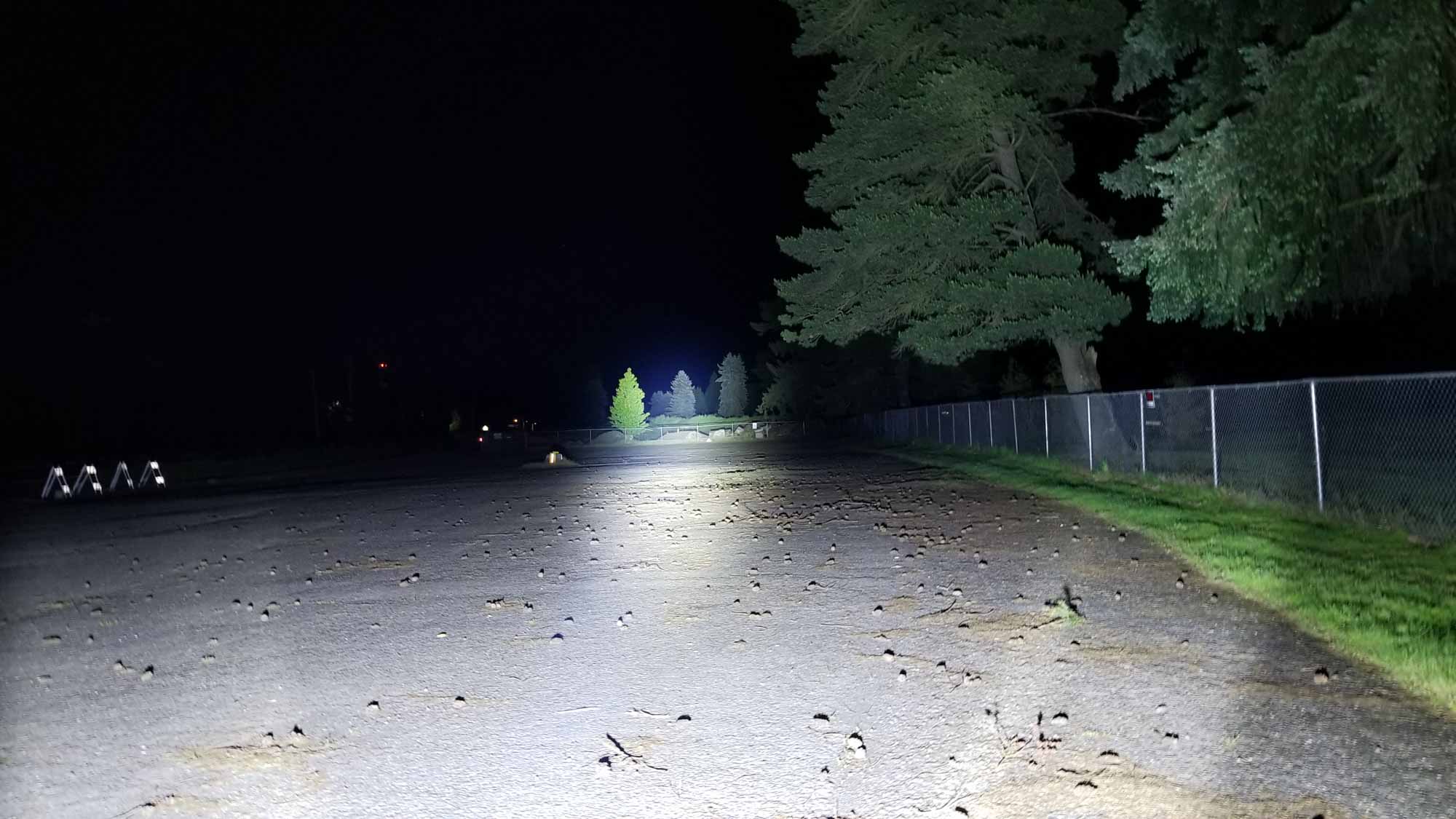

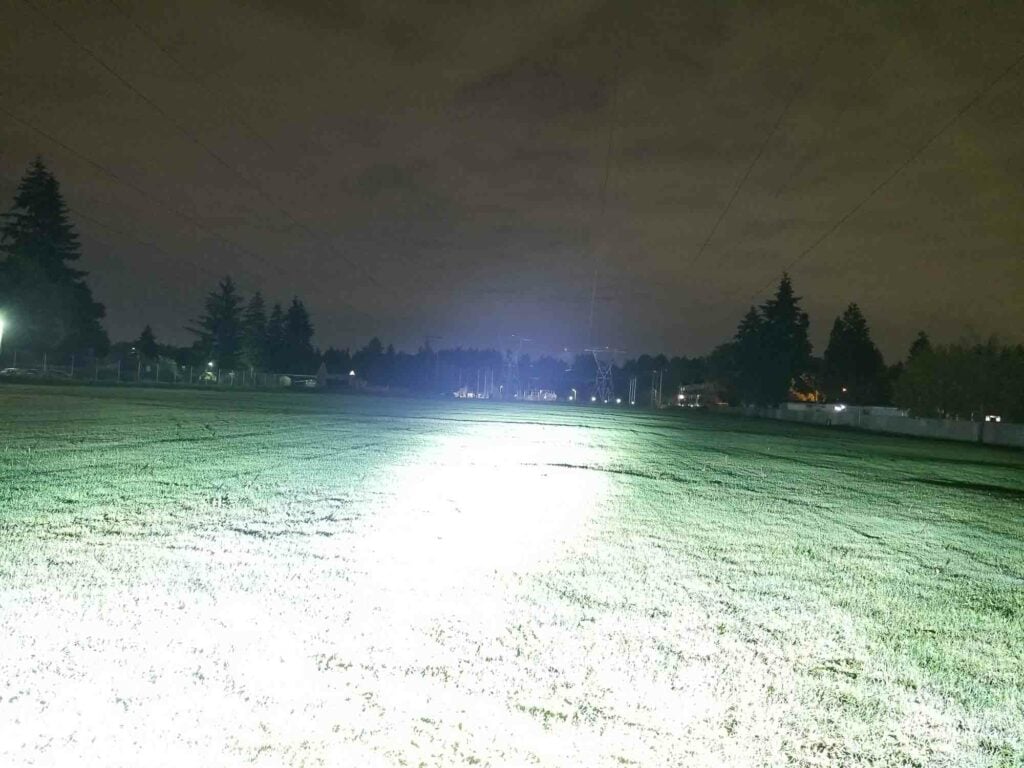
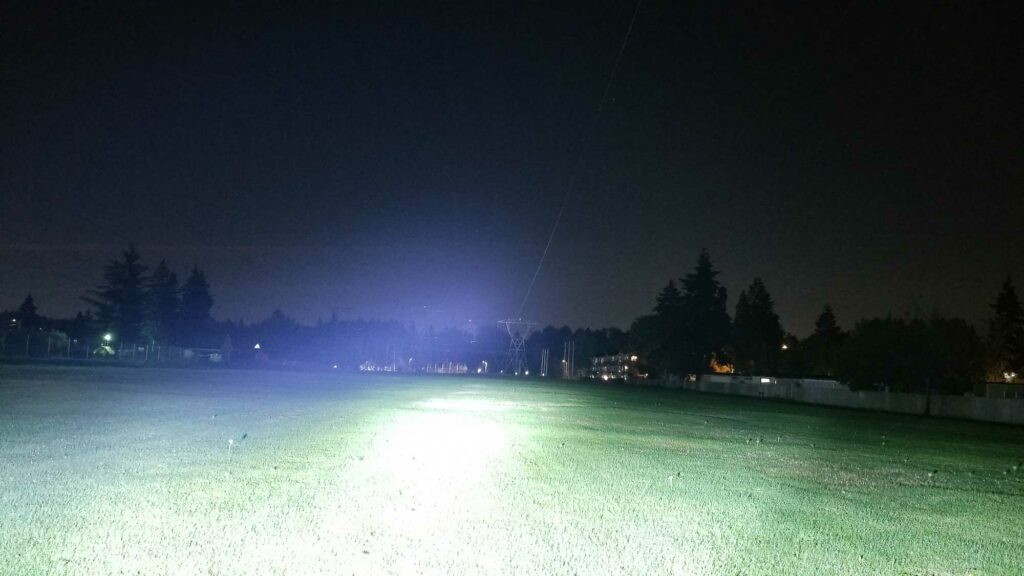
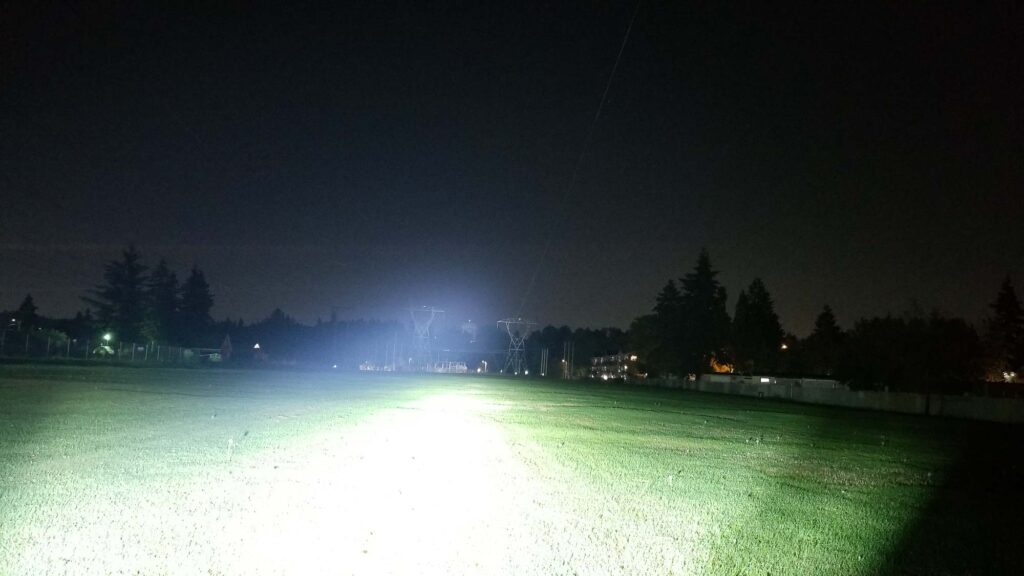
Disclaimer: This flashlight was sent to me for review at no cost by Nealsgadgets. I have not been paid to review, nor have I been holding back on problems or defects.
Final Verdict
Pros
- Very affordable
- Nice build quality
- Series cells and high power buck driver
- Onboard charging and power bank
- Doesn’t need button-top batteries
- Fully regulated runtimes
Cons
- Threads are a bit gritty
- UI takes some getting used to
- Didn’t meet output or beam distance specs
Explanation on star ratings:
1: Avoid: a match would be a better choice – 2: Poor: significant defect or issues; almost unusable – 3: Average: some defects or issues; but still usable 4: Good: recommended (minor issues) – 5: Great: highly recommended

4.5 stars: ★★★★⋆
After reviewing a few of their lights, I’ve deduced that Amutorch is sort of the best kept secret of the flashlight world. The DM80 further illustrates this point. I was pretty impressed with the DM90, and I’m tickled pink that the same features have been passed on to the DM80, namely the high-power buck driver. That’s sort of a rare feature in this price bracket since those drivers are expensive. The addition of onboard charging is also nice, and negates the need for a separate battery charger, plus you can use it as a power bank. Although some folks who buy this light probably won’t use it much, it’s still nice to have.
It’s got solid build quality, handles nicely, and has great sustainability with fully regulated output. You also get fully regulated output as well without any temperature regulation drama. It’s my opinion that the DM80 really is a viable alternative to the Manker MK38 at ⅓ the price. Marco tested the MK38 and the performance differences are negligible, except beam distance, so it begs the question: Should you buy the DM80 over the MK38? If you want to save a bunch of money and don’t care about the ‘fandle’ or fancy finish, then by all means go for the DM80. You could buy a DM80, and with the money you saved buy a bunch of batteries, (or that He-Man with matching Battle Cat action figure you’ve been eyeing).
Amutorch has definitively proven it is possible to build a high power, long-throw flashlight with 8 SFT-40-W LEDs for $160. It’s a pretty versatile high output light with decent build quality, good handling, and a fantastic electronics package. It gets my seal of approval and 4.5 stars
Amutorch DM80 discount code
Get some extra discount with our unique coupon: 1LumenNew or 1Lumen711
1lumen selects and reviews products personally. We may earn affiliate commissions through our links, which help support our testing.